
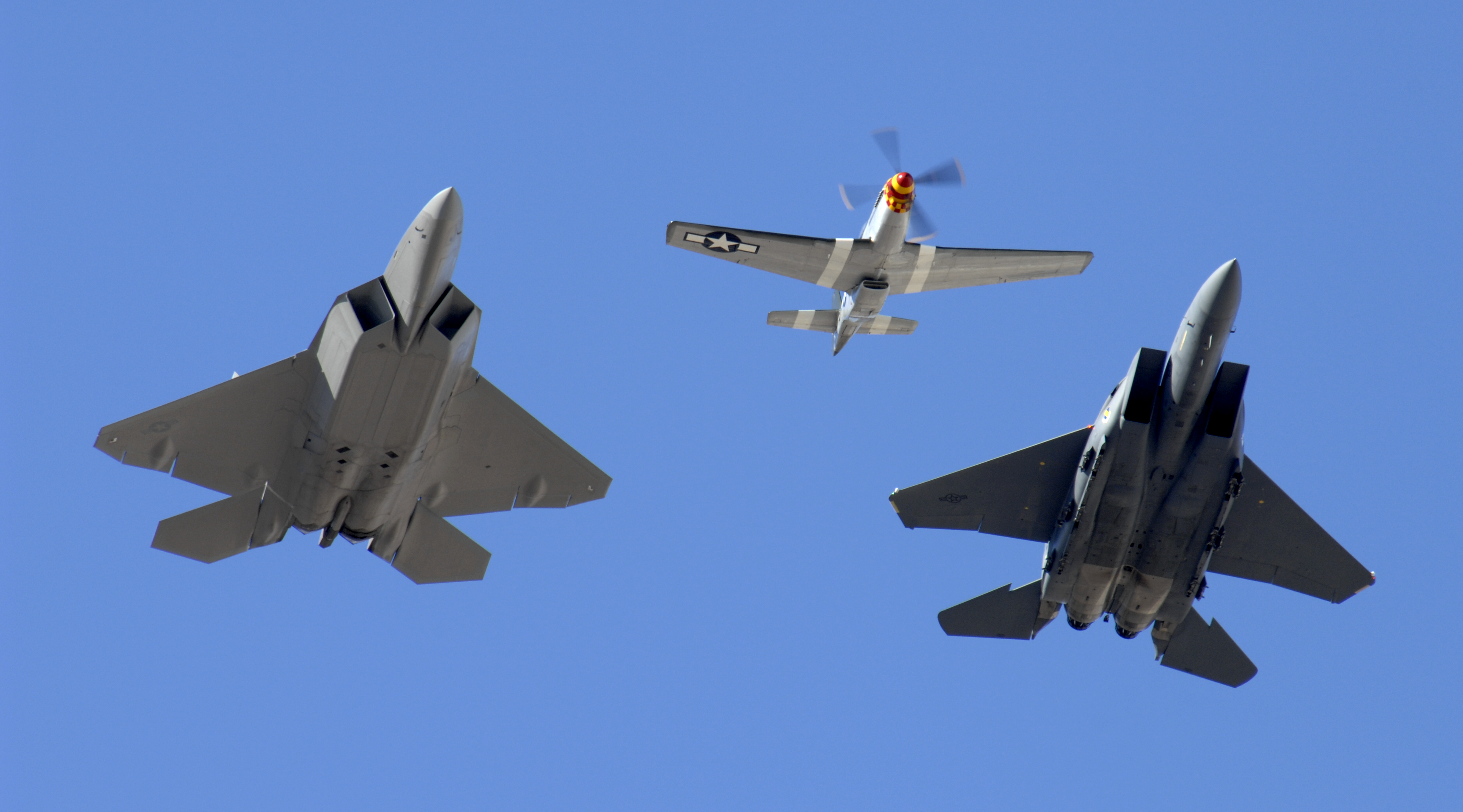
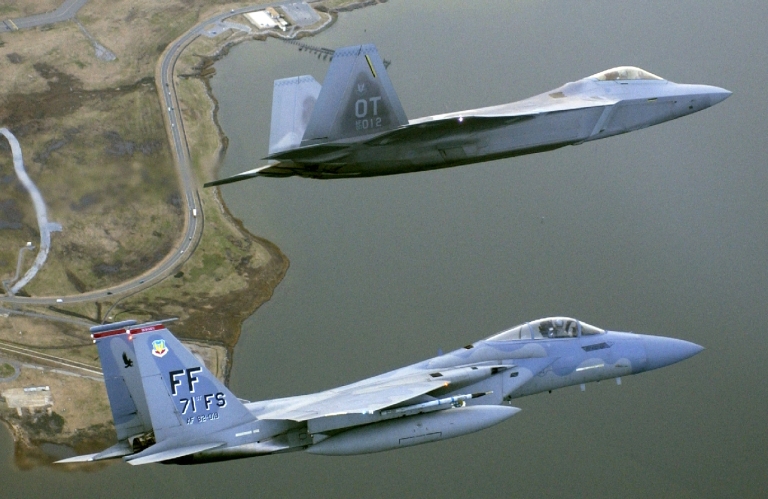

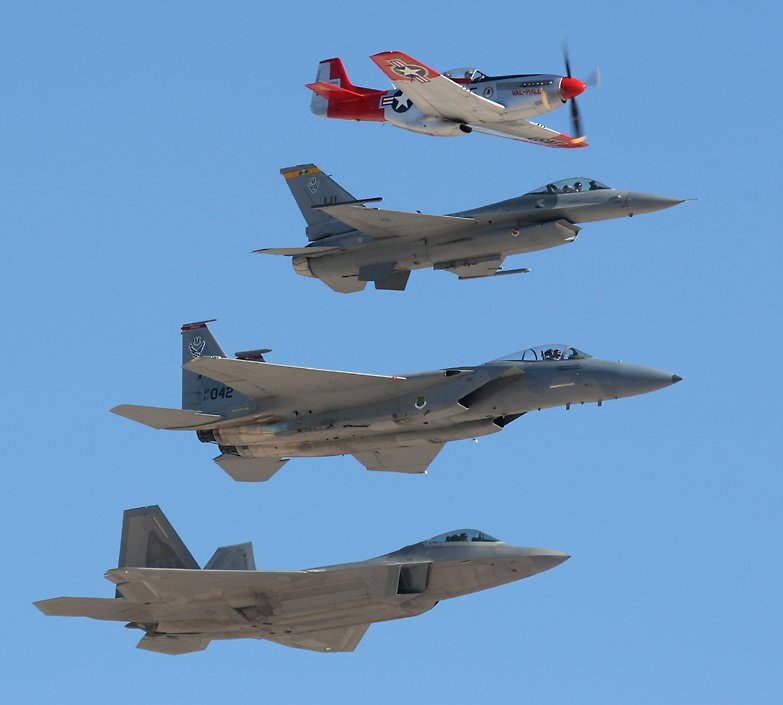





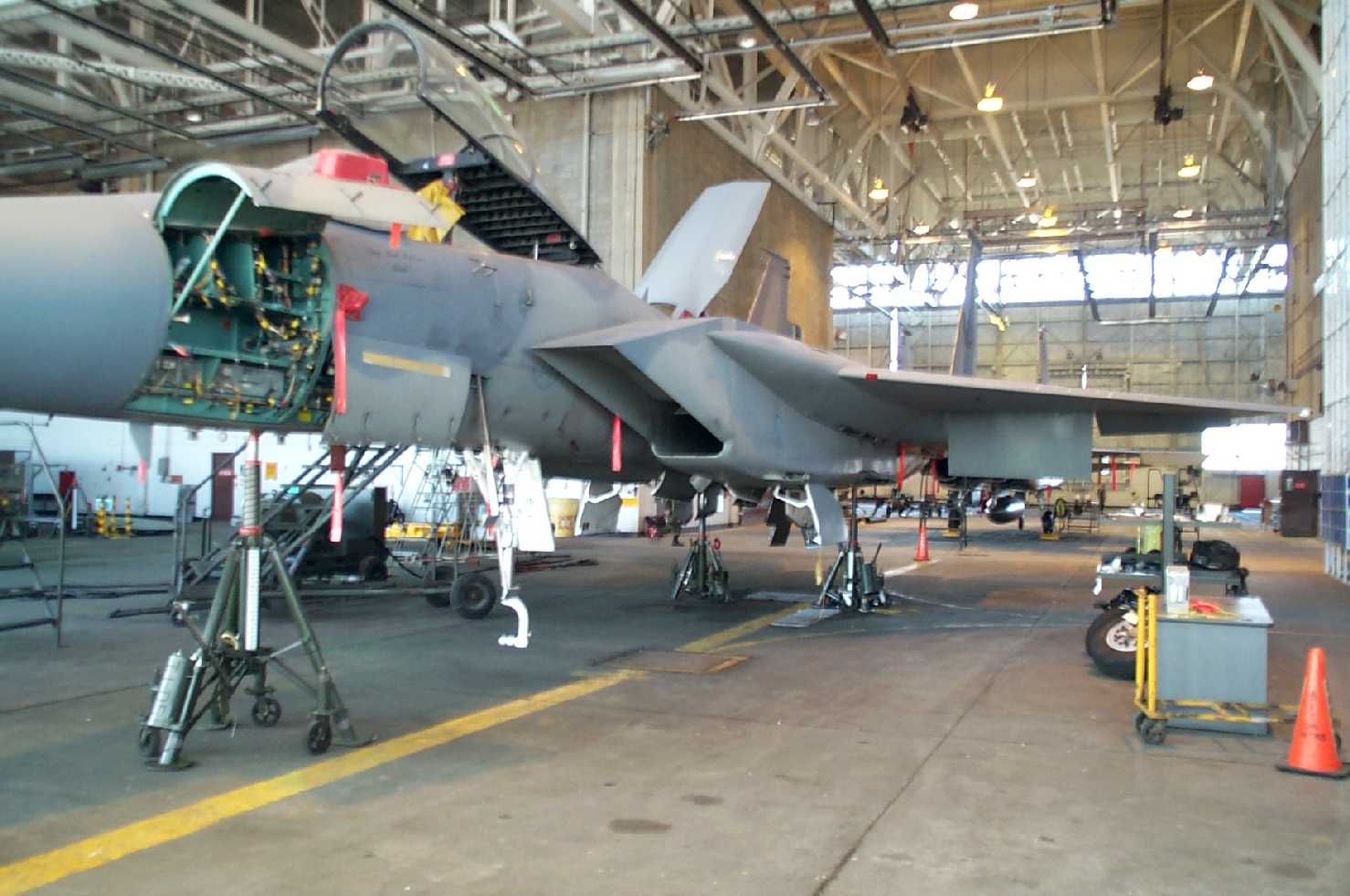







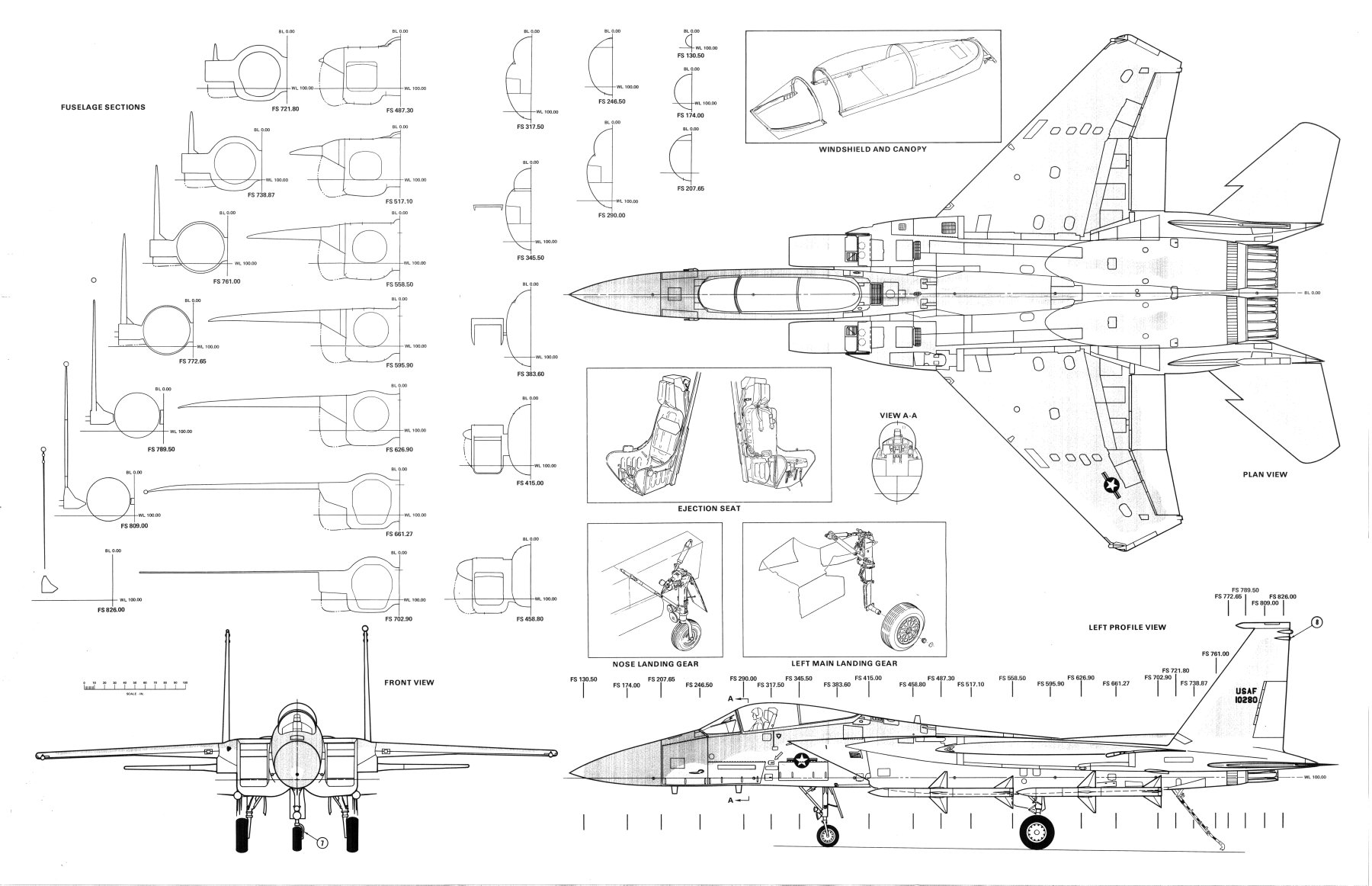
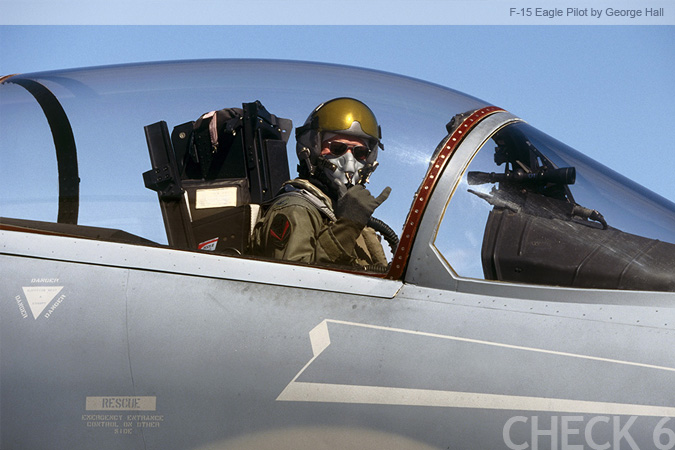

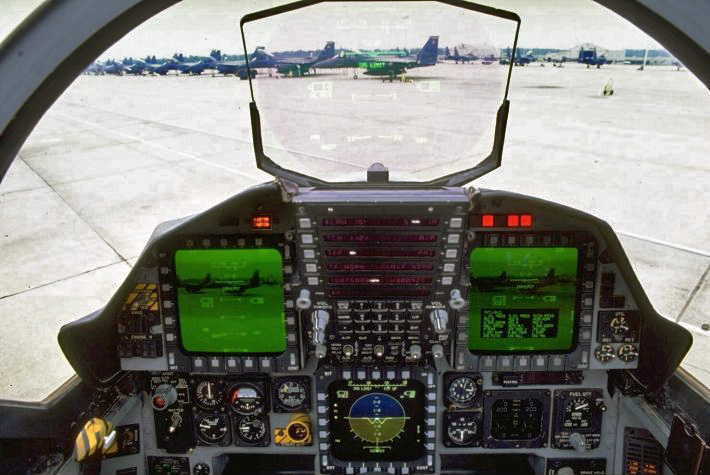


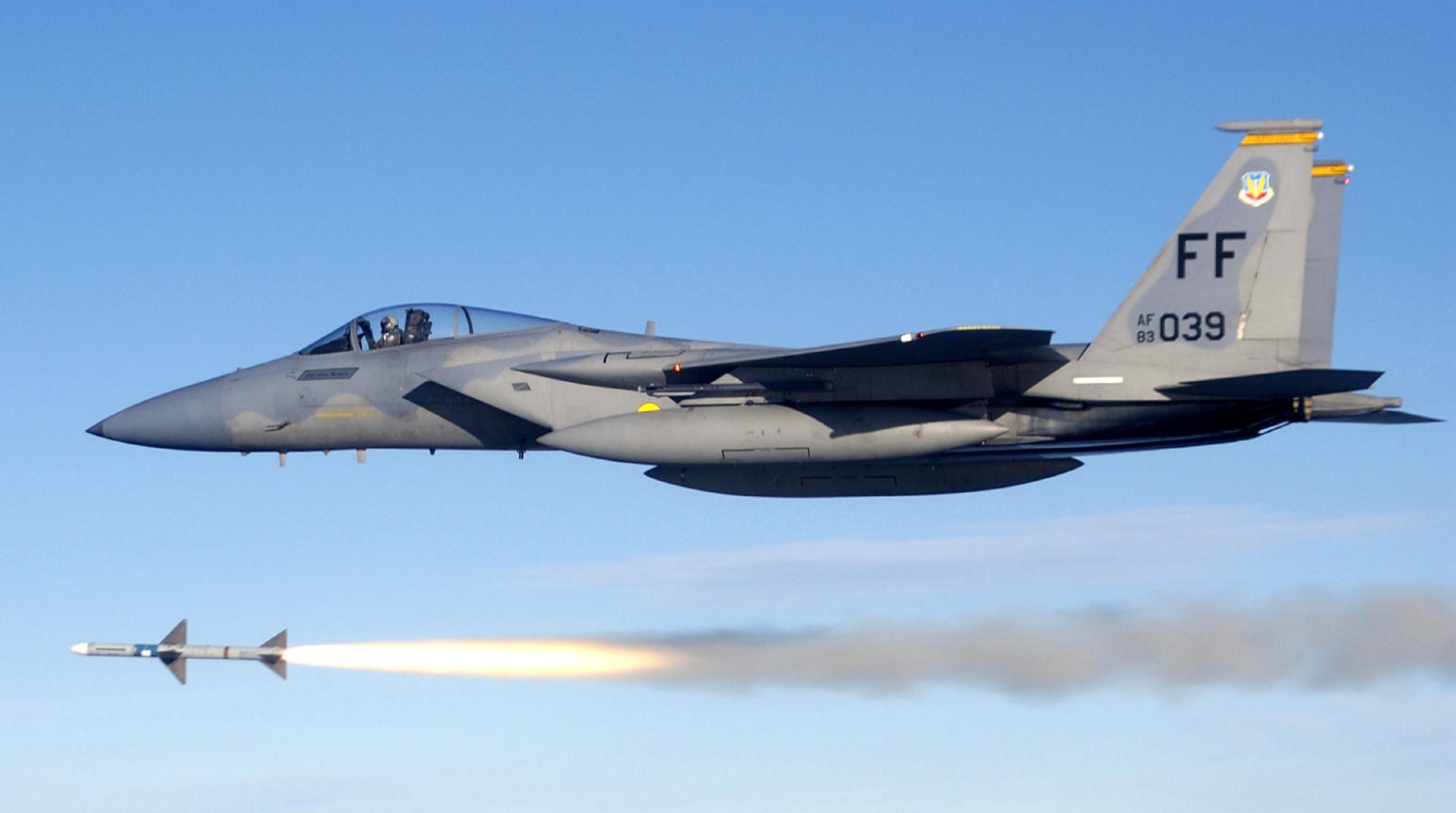
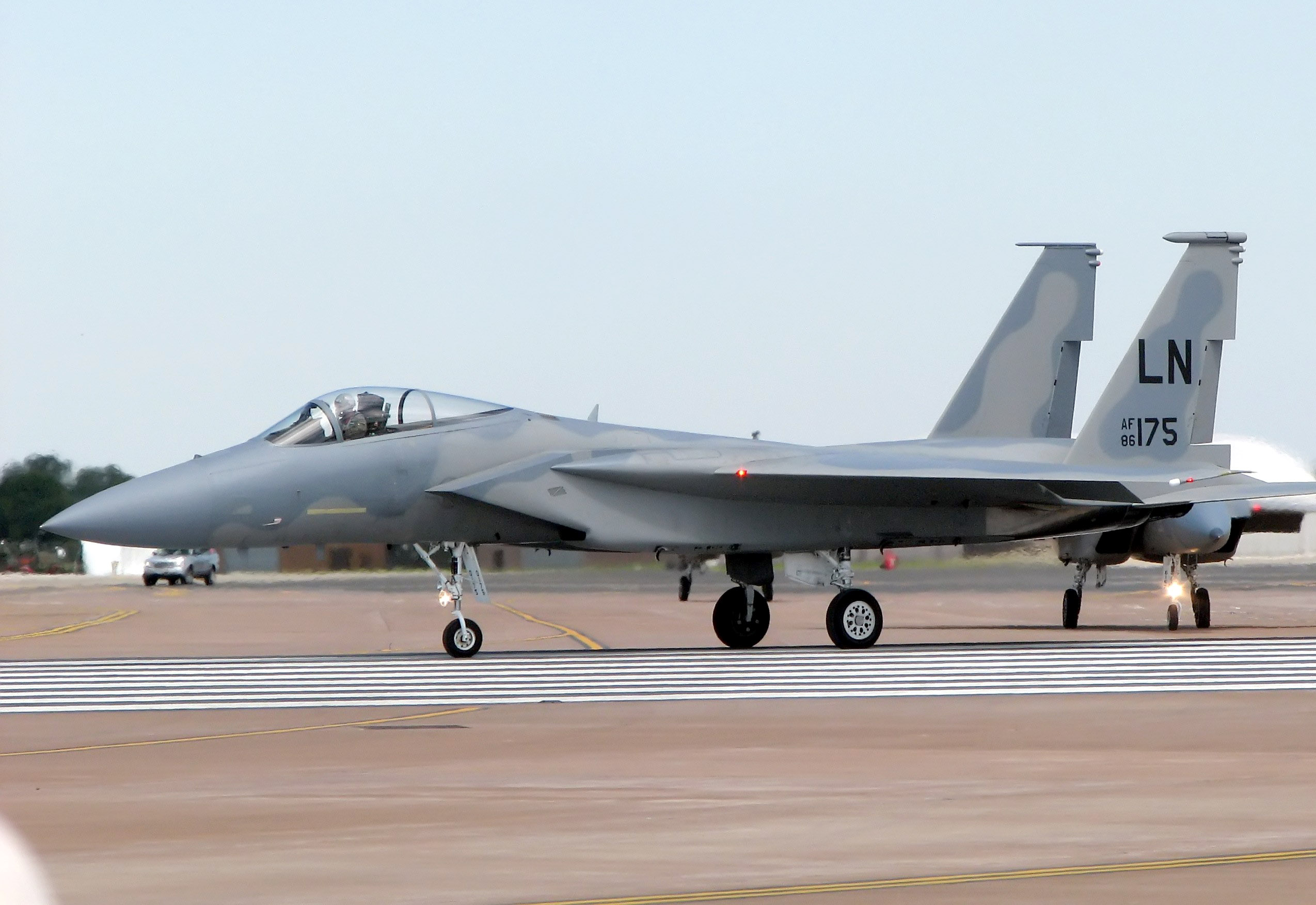




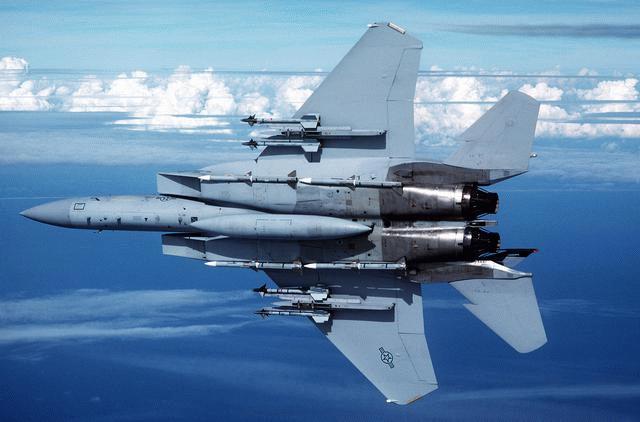
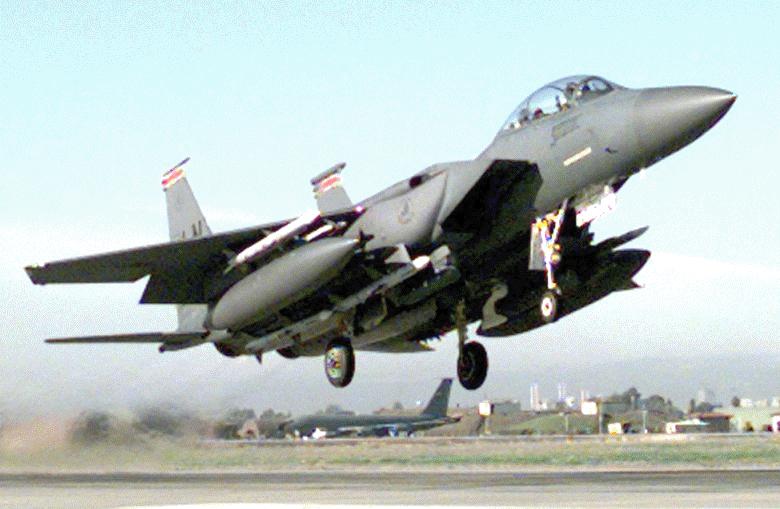
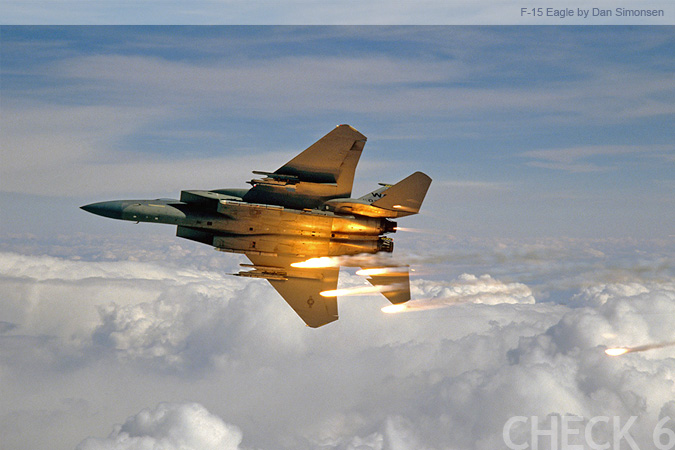

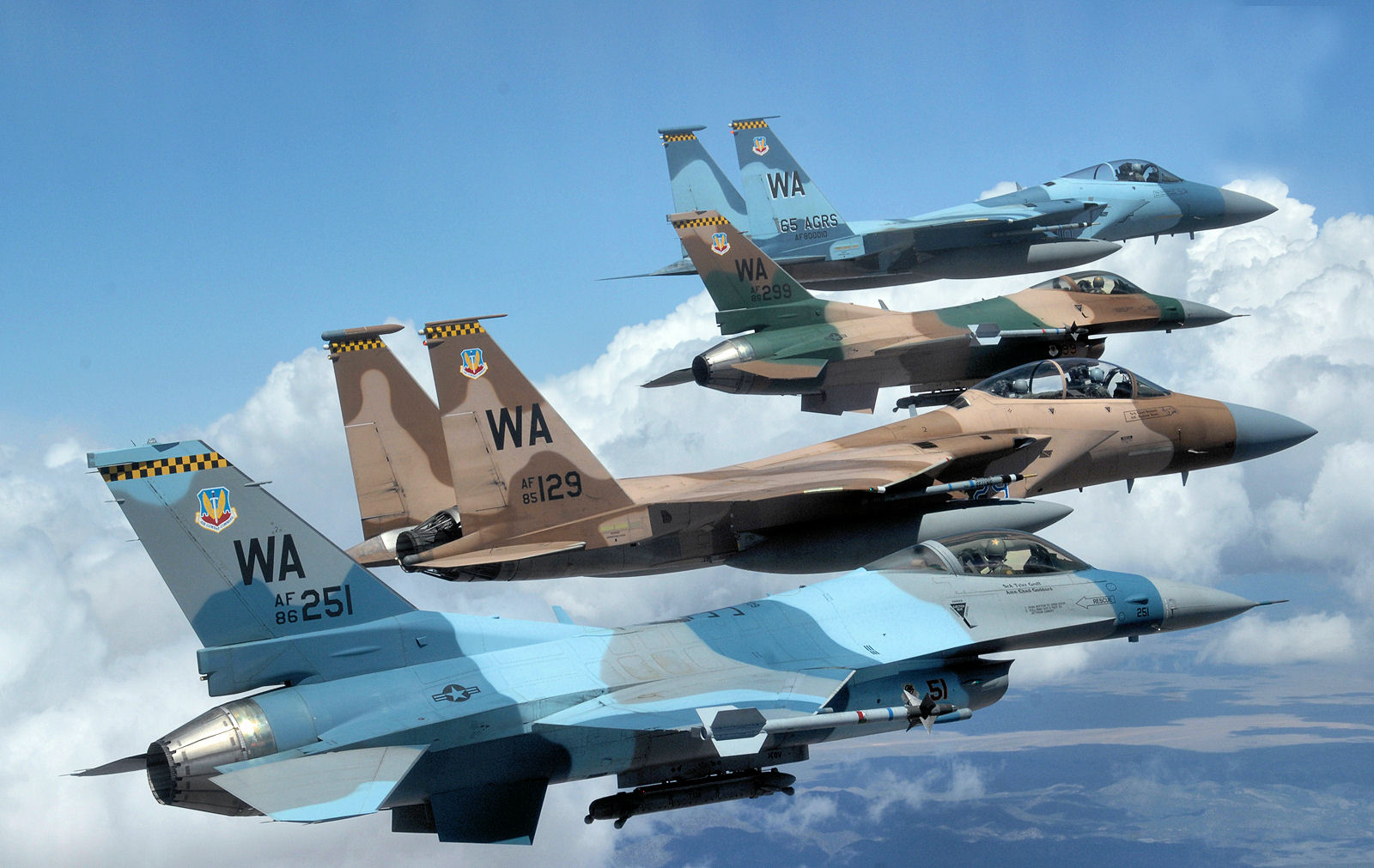

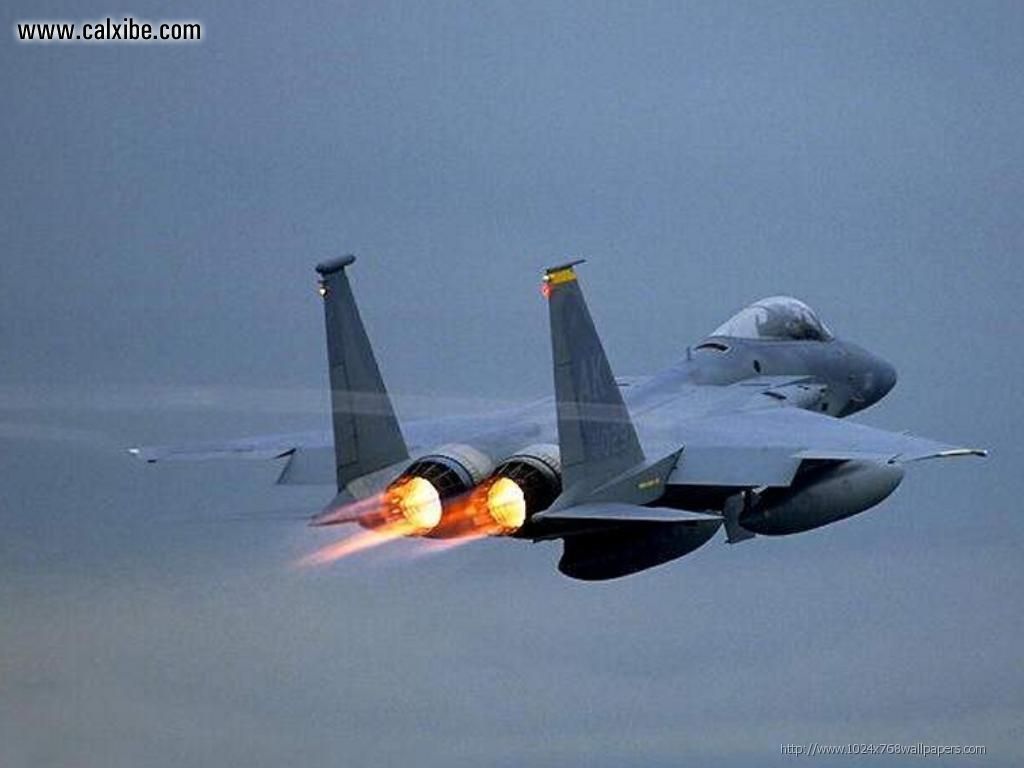

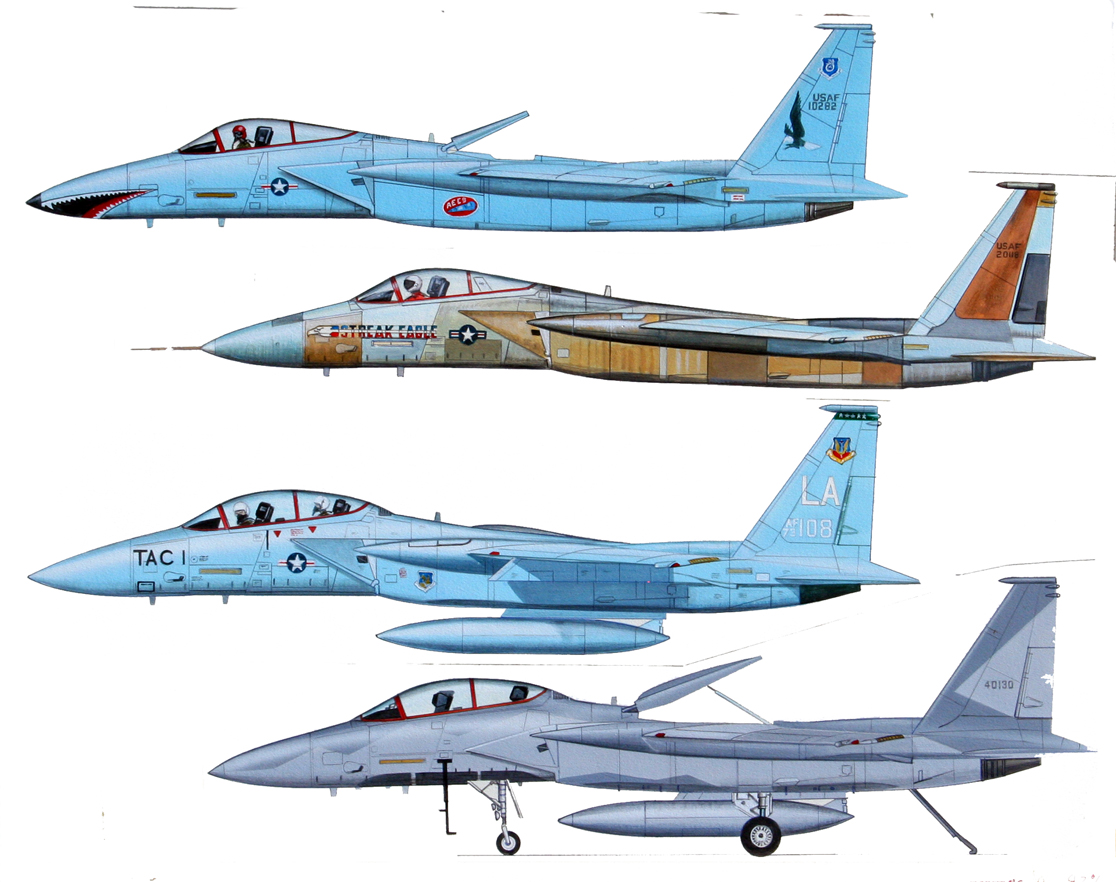

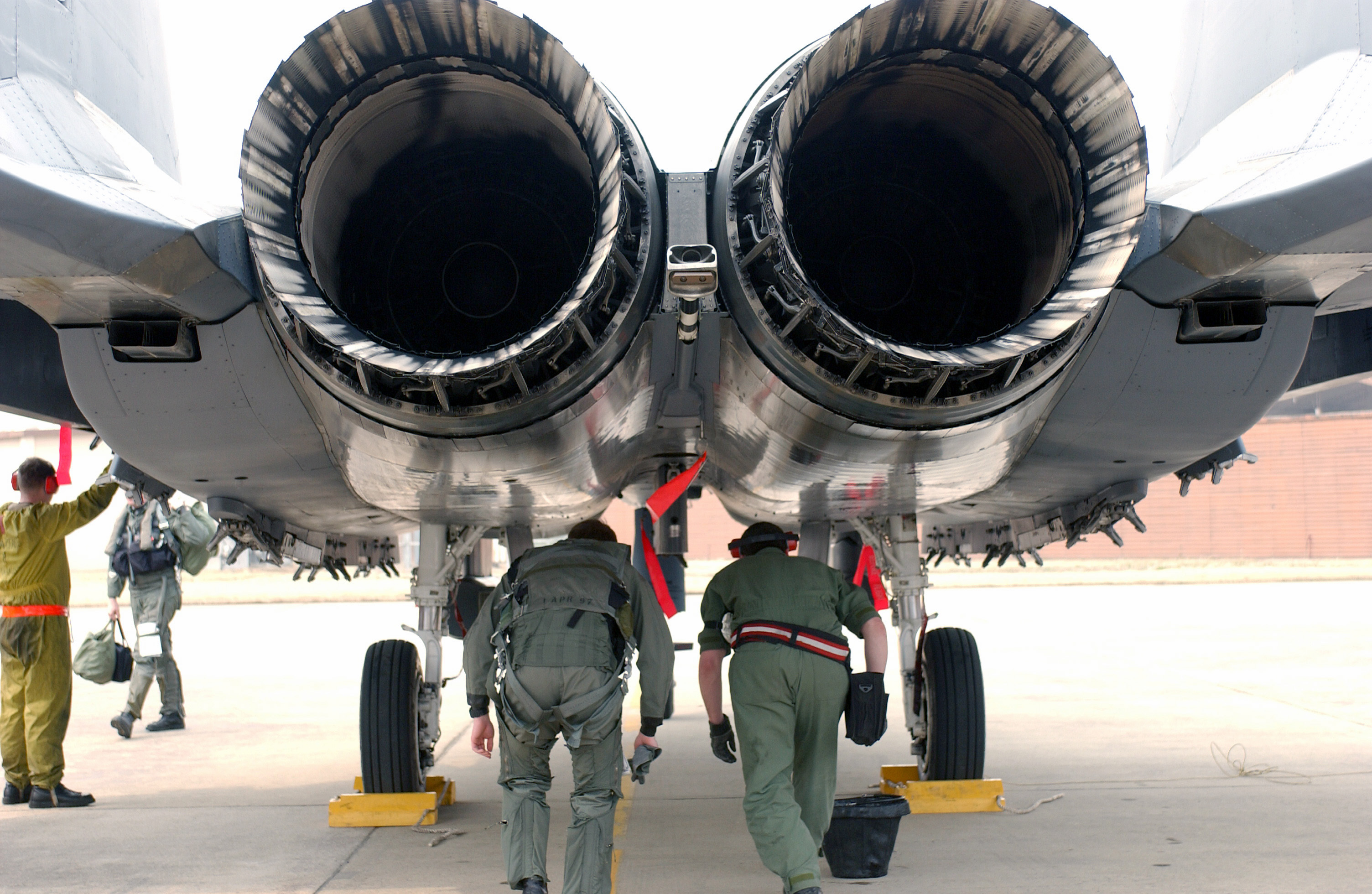
McDonnell Douglas F-15 Eagle
From Wikipedia, the free encyclopedia
This article is about the initial F-15 fighter versions. For the current production versions, see McDonnell Douglas F-15E Strike Eagle.
| F-15 Eagle | |
|---|---|
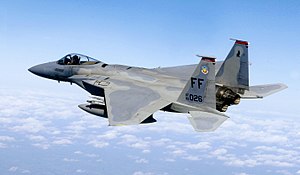 |
|
| USAF F-15C during Operation Noble Eagle patrol | |
| Role | Air superiority fighter |
| Manufacturer | McDonnell Douglas Boeing Defense, Space & Security |
| First flight | 27 July 1972 |
| Introduction | 9 January 1976 |
| Status | In service |
| Primary users | United States Air Force Japan Air Self-Defense Force Royal Saudi Air Force Israeli Air Force |
| Number built | F-15A/B/C/D/J/DJ: 1,198[1] |
| Unit cost |
F-15A/B: US$28 million (1998)
F-15C/D: US$30 million (1998)[2] |
| Variants | McDonnell Douglas F-15E Strike Eagle McDonnell Douglas F-15 STOL/MTD Boeing F-15SE Silent Eagle Mitsubishi F-15J |
Since the 1970s, the Eagle has been exported to Israel, Japan, Saudi Arabia, and other nations. The F-15 was originally envisioned as a pure air superiority aircraft. Its design included a secondary ground-attack capability[5] that was largely unused. The design proved flexible enough that an all-weather strike derivative, the F-15E Strike Eagle, was later developed, and entered service in 1989. The F-15 Eagle is expected to be in service with the U.S. Air Force past 2025.[6] F-15 versions are still being produced for foreign users, with the F-15 production line set to end in 2019, 47 years after the type's first flight.[7]
Contents
Development
Origins
The F-15 can trace its origins, ultimately, to ongoing fights between the USAF and US Navy over tactical support aircraft being used in the Vietnam War. At the time, Robert McNamara was pressing for both services to use as many common aircraft as possible, even if there were performance sacrifices involved. As part of this policy, the USAF and Navy were involved in the TFX program, aiming to deliver a medium-range interdiction aircraft in Air Force use, and a long-range interceptor aircraft for the Navy.[8]In January 1965, McNamara asked the Air Force to consider a new low-cost tactical fighter design for short-range roles and close air support. This would replace a collection of types like the F-100 Super Sabre and a variety of light bomber designs then in service. Two basic designs could fill this role; the Navy favored designs like the A-4 Skyhawk and LTV A-7 Corsair II, pure attack aircraft, while the Air Force was more interested in fighter-bombers like the Northrop F-5, fighters with a secondary attack capability. The former were more capable in the tactical role, while the latter might be less so, but were able to defend themselves. If the Air Force did choose an attack design, maintaining air superiority would be a top priority. The next month, a report by Lt. Co. John Bohn on light tactical aircraft suggested the Air Force purchase the F-5 or A-7, and consider a new higher-performance aircraft to ensure its air superiority. This point was driven home after the loss of two F-105 Thunderchief aircraft to seemingly outdated MiG-15s or MiG-17s on 4 April 1965.[8]
In April 1965, Harold Brown, at that time director of the DDR&E, stated the favored position was to consider the F-5, and begin studies of the "F-X".[N 1] These early studies envisioned a production run of 800 to 1000 aircraft, and stressed maneuverability over speed. But it also stated that the aircraft would not be considered unless it had some level of ground attack capability.[9] On 1 August Gabriel Disosway took command of Tactical Air Command (TAC) and reiterated calls for the F-X, but lowered the required performance from Mach 3 to 2.5 in an effort to lower costs.[10] Ultimately, the Air Force would choose the A-7 over the F-5 for the support role on 5 November 1965,[11] giving further impetus to the need for an air superiority design as the A-7 lacked any credible air-to-air capability.
An official requirements document was finalized in October, and sent out as a request for proposals (RFP) to 13 companies on 8 December 1965. Eight companies responded with proposals. Following a downselect, four companies were asked to provide further developments. In total, they developed some 500 design concepts. Typical designs featured variable-sweep wings, weighed over 60,000 pounds (27,000 kg), included a top speed of Mach 2.7 and a thrust-to-weight ratio of 0.75.[12] When the proposals were studied in July 1966, the aircraft were roughly the size and weight of the TFX, and like that aircraft, a design that could not be considered an air superiority fighter.[13]
Smaller, lighter
Through this period, studies of combat over Vietnam were producing worrying results. Previous doctrine had stressed long-range combat using missiles, and optimized aircraft for this role. The result was highly loaded aircraft with large radars and excellent speed, but limited maneuverability and often lacking a gun. The canonical example was the McDonnell Douglas F-4 Phantom II, used by the USAF, U.S. Navy and U.S. Marine Corps to provide air superiority over Vietnam, the only fighter with enough power, range, and maneuverability to be given the primary task of dealing with the threat of Soviet fighters while flying with visual engagement rules.[14]In practice, both due to policy and practical reasons,[14] aircraft were closing to visual range and maneuvering, placing the larger US aircraft at a disadvantage to the much less expensive day fighters like the MiG-21. Moreover, missiles proved to be much less reliable than predicted, especially in close range combat. Although improved training and the introduction of the M61 Vulcan did much to address the disparity, these early outcomes led to considerable re-evaluation of the 1963 Project Forecast doctrine.[15] This led to John Boyd's Energy-Maneuverability (E-M) theory, which stressed that extra power and maneuverability were key aspects of a successful fighter design, and these were more important than outright speed. Through tireless championing of the concepts, and good timing with the "failure" of the initial F-X project, the "fighter mafia" pressed for a lightweight day fighter that could be built and operated in large numbers in order to ensure air superiority.[16] In early 1967, they proposed that the ideal design had a thrust-to-weight ratio of near 1:1, a maximum speed further reduced to Mach 2.3, a weight of 40,000 pounds (18,000 kg) and a wing loading of 80 lb/ft².[17]
By this time, the Navy had decided the F-111 would not meet their requirements, and began development of a new dedicated fighter design, the VFAX program. In May 1966, McNamara once again asked the forces to study the designs and see if the VFAX would meet the Air Force's F-X needs. The resulting studies took eighteen months, and concluded that the desired features were simply too different; the Navy stressed loiter time and mission flexibility, while the Air Force was now looking primarily for maneuverability.[18]
Focus on air superiority
In 1967 the Soviet Union revealed the MiG-25 'Foxbat' at the Domodedovo airfield near Moscow.[14][19] The MiG-25 was designed as a high-speed, high-altitude interceptor aircraft, and made many performance tradeoffs to excel in this role.[20] Among these was the requirement for very high speed, over Mach 2.8, which demanded the use of stainless steel instead of aluminum in many locations on the aircraft. The added weight demanded a much larger planform to allow the aircraft to operate at the required high altitudes. However, to observers, it appeared outwardly similar to the very large F-X studies, an aircraft with high speed and a large wing offering high maneuverability; leading to serious concerns throughout the Department of Defense and the various arms that the US was being outclassed. The MiG-23 was likewise a subject of concern and it was generally believed this was a better aircraft than the F-4. The F-X would outclass the MiG-23, but now it appeared that that MiG-25 would be superior in speed, ceiling and endurance to all existing US fighters, even the F-X.[21] Thus, an effort to improve the F-X followed.[22]Both Headquarters USAF and the TAC continued to call for a multipurpose aircraft, but by this time both Disosway and Air Chief of Staff Bruce K. Holloway were pressing for a pure air superiority design that would be able to meet the expected performance of the MiG-25. During the same period, the Navy had ended its VFAX program and instead accepted a proposal from Grumman Aircraft for a smaller and more maneuverable design known as VFX. VFX was considerably closer to the evolving F-X requirements. The in-fighting in the Air Force was eventually ended by the worry that the Navy's VFAX would be forced on them, and in May 1968 it was stated that "We finally decided - and I hope there is no one who still disagrees - that this aircraft is going to be an air superiority fighter".[18]
Final design
Four companies submitted proposals, with the Air Force eliminating General Dynamics and awarding contracts to Fairchild Republic, North American Rockwell, and McDonnell Douglas for the definition phase in December 1968. The companies submitted technical proposals by June 1969. The Air Force announced the selection of McDonnell Douglas on 23 December 1969.[25] The winning design resembled the twin-tailed F-14, but with fixed wings; both designs were based on configurations studied in wind tunnel testing by NASA.[26]
The Eagle's initial versions were the F-15 single-seat variant and TF-15 twin-seat variant. (After the F-15C was first flown in 1980 the designations were changed to "F-15A" and "F-15B"). These versions would be powered by new Pratt & Whitney F100 engines to achieve a combat thrust-to-weight ratio in excess of 1:1. A proposed 25 mm Ford-Philco GAU-7 cannon with caseless ammunition suffered development problems. It was dropped in favor of the standard M61 Vulcan gun. The F-15 used conformal carriage of four Sparrow missiles like the Phantom. The fixed wing was put onto a flat, wide fuselage that also provided an effective lifting surface. The first F-15A flight was made on 27 July 1972 with the first flight of the two-seat F-15B following in July 1973.[27]
The F-15 has a "look-down/shoot-down" radar that can distinguish low-flying moving targets from ground clutter. The F-15 would use computer technology with new controls and displays to lower pilot workload and require only one pilot to save weight. Unlike the F-14 or F-4, the F-15 has only a single canopy frame with clear vision forward. The USAF introduced the F-15 as "the first dedicated USAF air superiority fighter since the North American F-86 Sabre."[28]
The F-15 was favored by customers such as the Israel and Japan air arms. Criticism from the fighter mafia that the F-15 was too large to be a dedicated dogfighter, and too expensive to procure in large numbers, led to the Lightweight Fighter (LWF) program, which led to the USAF General Dynamics F-16 Fighting Falcon and the middle-weight Navy McDonnell Douglas F/A-18 Hornet.[29]
Further development
The single-seat F-15C and two-seat F-15D models entered production in 1978 and conducted their first flights in February and June of that year.[30] These models were fitted with the Production Eagle Package (PEP 2000), which included 2,000 lb (900 kg) of additional internal fuel, provisions for carrying exterior conformal fuel tanks, and an increased maximum takeoff weight of up to 68,000 lb (30,700 kg).[31] The increased takeoff weight allows internal fuel, a full weapons load, conformal fuel tanks, and three external fuel tanks to be carried. The APG-63 radar uses a programmable signal processor (PSP), enabling the radar to be reprogrammable for additional purposes such as the addition of new armaments and equipment. The PSP was the first of its kind in the world, and the upgraded APG-63 radar was the first radar to use it. Other improvements on the C and D models included strengthened landing gear, a new digital central computer,[32] and an overload warning system, which allows the pilot to fly the fighter to 9 g at all weights.[30]The F-15 Multistage Improvement Program (MSIP) was initiated in February 1983 with the first production MSIP F-15C produced in 1985. Improvements included an upgraded central computer; a Programmable Armament Control Set, allowing for advanced versions of the AIM-7, AIM-9, and AIM-120A missiles; and an expanded Tactical Electronic Warfare System that provides improvements to the ALR-56C radar warning receiver and ALQ-135 countermeasure set. The final 43 F-15Cs included the enhanced-capability Hughes APG-70 radar, which was developed for the F-15E. These 43 F-15Cs with APG-70 radar are sometimes referred as Enhanced Eagles. Earlier MSIP F-15Cs with the APG-63 were upgraded to the APG-63(V)1 to significantly improve maintainability and enable performance similar to the APG-70. Existing F-15s were retrofitted with these improvements.[33]
In 1979, McDonnell Douglas and F-15 radar manufacturer, Hughes, teamed to privately develop a strike fighter version of the F-15. This version competed in the Air Force's Dual-Role Fighter competition starting in 1982. The Boeing F-15E strike variant was selected for production in 1984.[34] Beginning in 1985, F-15C and D models were equipped with the improved P&W F100-220 engine and digital engine controls, providing quicker throttle response, reduced wear, and lower fuel consumption. Starting in 1997, original F100-100 engines were upgraded to a similar configuration with the designation F100-220E starting.[35]
Beginning in 2007, 178 USAF F-15Cs were retrofitted with the AN/APG-63(V)3 Active Electronically Scanned Array (AESA) radar.[36] A significant number of F-15s are to be equipped with the Joint Helmet Mounted Cueing System (JHMCS).[37] Lockheed Martin is working on an IRST system for the F-15C.[38] A follow-on upgrade called the Eagle passive/active warning survivability system (EPAWSS) was planned but remained unfunded.[39] The EPAWSS upgrade will include sophisticated jamming, integrated digital RWR/ geo-location and electro-optical/ IR threat detection and decoy capabilities.[40]
Design
Overview
The F-15 has an all-metal semi-monocoque fuselage with a large cantilever shoulder-mounted wing. The empennage is metal and composite construction, with twin aluminum/composite honeycomb fins with boron-composite skins, resulting in an exceptionally thin tailplane and rudders with all-moving composite horizontal tail surfaces outboard of the fins. The F-15 has a spine-mounted air brake and retractable tricycle landing gear. It is powered by two Pratt & Whitney F100 axial-flow turbofan engines with afterburners mounted side-by-side in the fuselage. The cockpit is mounted high in the forward fuselage with a one-piece windscreen and large canopy to increase visibility. The airframe began to incorporate advanced superplastically formed titanium components in the 1980s.The F-15's maneuverability is derived from low wing loading (weight to wing area ratio) with a high thrust-to-weight ratio enabling the aircraft to turn tightly without losing airspeed. The F-15 can climb to 30,000 ft (10,000 m) in around 60 seconds. The thrust output of the dual engines is greater than the aircraft's weight, thus giving it the ability to accelerate in a vertical climb. The weapons and flight control systems are designed so that one person can safely and effectively perform air-to-air combat.[41] The A and C-models are single-seat variants; these were the main air superiority versions produced. B and D-models add a second seat behind the pilot for training. E-models use the second seat for a weapon systems officer. Visibly, the F-15 has a unique feature vis-à-vis other modern fighter aircraft: it does not have the distinctive turkey feather aerodynamic exhaust petals covering its engine nozzles. This is because the petal design on the F-15 was problematic and could fall off in flight; therefore they were removed, resulting in a 3% drag increase.[42]
Avionics

The heads-up display projects, through a combiner, all essential flight information gathered by the integrated avionics system. This display, visible in any light condition, provides the pilot information necessary to track and destroy an enemy aircraft without having to look down at cockpit instruments.[44]
The F-15's versatile APG-63 and 70 pulse-Doppler radar systems can look up at high-flying targets and down at low-flying targets without being confused by ground clutter. These radars can detect and track aircraft and small high-speed targets at distances beyond visual range down to close range, and at altitudes down to treetop level. The APG-63 has a basic range of 100 miles (87 nmi; 160 km). The radar feeds target information into the central computer for effective weapons delivery. For close-in dogfights, the radar automatically acquires enemy aircraft, and this information is projected on the heads-up display. The F-15's electronic warfare system provides both threat warning and automatic countermeasures against selected threats.[45]
Weaponry and external stores
The Eagle can be armed with combinations of four different air-to-air weapons: AIM-7F/M Sparrow missiles or AIM-120 AMRAAM advanced medium range air-to-air missiles on its lower fuselage corners, AIM-9L/M Sidewinder or AIM-120 AMRAAM missiles on two pylons under the wings, and an internal M61A1 20 millimetres (0.79 in) Gatling gun in the right wing root.[47]
Low-drag conformal fuel tanks (CFTs) were developed for the F-15C and D models. They can be attached to the sides of the engine air intake trunks under each wing and are designed to the same load factors and airspeed limits as the basic aircraft.[47] They degrade performance by increasing drag and cannot be jettisoned in-flight (unlike conventional external tanks). Each conformal fuel tank can hold 750 U.S. gallons (2,840 L) of fuel.[48] These tanks increase range and reduce the need for in-flight refueling. All external stations for munitions remain available with the tanks in use. Moreover, Sparrow or AMRAAM missiles can be attached to the corners of the conformal fuel tanks.[31] The 57 FIS based at Keflavik NAS, Iceland was the only C-model squadron to use CFTs on a regular basis due to its extended operations over the North Atlantic. With the closure of the 57 FIS, the F-15E is the only variant to carry them on a routine basis. CFTs have also been sold to Israel and Saudi Arabia.
Upgrades
The APG-63(V)2 Active Electronically Scanned Array (AESA) radar has been retrofitted to 18 U.S. Air Force F-15C aircraft.[50] This upgrade includes most of the new hardware from the APG-63(V)1, but adds an AESA to provide increased pilot situational awareness. The AESA radar has an exceptionally agile beam, providing nearly instantaneous track updates and enhanced multi-target tracking capability. The APG-63(V)2 is compatible with current F-15C weapon loads and enables pilots to take full advantage of AIM-120 capabilities, simultaneously guiding multiple missiles to several targets widely spaced in azimuth, elevation, or range.
Operational history
Introduction and early service
The largest operator of the F-15 is the United States Air Force. The first Eagle (F-15B) was delivered 13 November 1974.[51] In January 1976, the first Eagle destined for a combat squadron, the 555th TFS, was delivered.[51] These initial aircraft carried the Hughes Aircraft (now Raytheon) APG-63 radar.The first F-15 kill was scored by Israeli Air Force (IAF) ace Moshe Melnik in 1979.[52] In 1979–81, during Israeli raids against Palestinian factions based in Lebanon, F-15As claimed downing 13 Syrian MiG-21 "Fishbeds" and two Syrian MiG-25 "Foxbats", the latter being the aircraft the F-15 was designed to kill. Syrians have confirmed the loss of 11 MiG-21s and two MiG-25s and claimed downing five F-15s(three by MiG-21s and two by MiG-25s). Plus two F-15s were downed by SAM.[53] Israeli F-15As and Bs participated as escorts in Operation Opera and served during the 1982 Lebanon War. During the latter, Israeli F-15s shot down 40 Syrian jet fighters (23 MiG-21 "Fishbeds" and 17 MiG-23 "Floggers") and one Syrian SA.342L Gazelle helicopter. According to Israel, some F-15s were damaged in air combat with MiG-21s. In one case, on 9 June, a MiG-21 scored a direct hit on an F-15's engine with an R-60 missile. One engine was totally destroyed and the F-15 caught fire. The second engine continued to work and the F-15 returned to base, enveloped in flames. However, according to Syria, five F-15s were shot down by MiG-21s and three by MiG-23MLs.[54][55] Later in 1985, during Operation Wooden Leg, IAF Eagles bombed the PLO headquarters in Tunisia.[56] This was one of the few times air superiority F-15s (A/B/C/D models) were used in tactical strike missions. The air to ground role for the air superiority variants became more frequently used in Israeli service from the early 2000s with the integration of GPS guided bombs.[57]
Royal Saudi Air Force F-15C pilots reportedly shot down two Iranian Air Force F-4E Phantom IIs in a skirmish in June 1984.[58][59]
Anti-satellite trials
The third test flight involved a retired P78-1 solar observatory satellite in a 345-mile (555 km) orbit, which was destroyed by kinetic energy.[62] The pilot, USAF Major Wilbert D. "Doug" Pearson, became the only pilot to destroy a satellite.[63] The ASAT program involved five test launches. The program was officially terminated in 1988.[60][63]
Gulf War and aftermath
The USAF began deploying F-15C, D and E model aircraft to the Persian Gulf region in August 1990 for Operations Desert Shield and Desert Storm. During Gulf War combat against Iraqi forces, the F-15 accounted for 36 of the 39 air-to-air victories by the U.S Air Force. Iraq has confirmed the loss of 23 of its aircraft in air-to-air combat.[64] F-15Es were operated mainly at night, hunting modified SCUD missile launchers and artillery sites using the LANTIRN system.[65] According to the USAF, its F-15Cs had 34 confirmed kills of Iraqi aircraft during the 1991 Gulf War, mostly by missile fire: five MiG-29 "Fulcrums", two MiG-25 "Foxbats", eight MiG-23 "Floggers", two MiG-21 "Fishbeds", two Su-25 "Frogfoots", four Su-22 "Fitters", one Su-7, six Mirage F1s, one Il-76 cargo plane, one Pilatus PC-9 trainer, and two Mi-8 helicopters, but not all these victories have confirmed by Iraq[citation needed]. Air superiority was achieved in the first three days of the conflict; many of the later kills were reportedly of Iraqi aircraft fleeing to Iran, rather than trying to engage U.S. aircraft. The single-seat F-15C was used for air superiority, and the F-15E was heavily used in air-to-ground attacks. An F-15E achieved an aerial kill of another Iraqi Mi-8 helicopter using a laser-guided bomb during the air war. The F-15E sustained two losses to ground fire in the Gulf War in 1991. Another one was damaged on the ground by a SCUD strike on Dhahran air base.[66]On 11 November 1990, a Saudi air force pilot defected with a F-15C fighter to Sudan during Operation Desert Shield. Saudi Arabia paid US$40 million for return of the aircraft, three months later.[67] RSAF F-15s shot down two Iraqi Mirage F1s during the Operation Desert storm.[68] According to Saudis, one F-15C was lost to a crash during the Gulf War in 1991.[69] The IRAF claims this fighter was part of two F-15Cs that engaged two Iraqi MiG-25PDs, and that this F-15C was hit by R-40 missile before crashing.[70]
Structural defects
All F-15 aircraft were grounded by the US Air Force after a Missouri Air National Guard F-15C came apart in flight and crashed on 2 November 2007. The newer F-15E fleet was later cleared for continued operations. The US Air Force reported on 28 November 2007 that a critical location in the upper longerons on the F-15C model was suspected of causing the failure, causing the fuselage forward of the air intakes, including the cockpit and radome, to separate from the airframe.[73]F-15A through D-model aircraft were grounded until the location received more detailed inspections and repairs as needed.[74] The grounding of F-15s received media attention as it began to place strains on the nation's air defense efforts.[75] The grounding forced some states to rely on their neighboring states' fighters for air defense protection, and Alaska to depend on Canadian Forces' fighter support.[75]
On 8 January 2008, the USAF Air Combat Command (ACC) cleared a portion of its F-15A through D-model fleet for return to flying status. It also recommended a limited return to flight for units worldwide using the affected models.[76] The accident review board report was released on 10 January 2008. The report stated that analysis of the F-15C wreckage determined that the longeron did not meet drawing specifications, which led to fatigue cracks and finally a catastrophic failure of the remaining support structures and breakup of the aircraft in flight.[77] In a report released on 10 January 2008, nine other F-15s were identified to have similar problems in the longeron. As a result of these problems, General John D. W. Corley stated that "the long-term future of the F-15 is in question."[78] On 15 February 2008, ACC cleared all its grounded F-15A/B/C/D fighters for flight pending inspections, engineering reviews and any needed repairs. ACC also recommended release of other U.S. F-15A/B/C/D aircraft.[79]
Recent service
Indian Air Force (IAF) Su-30MKs, MiG-29s and other fighters achieved success in air combat exercises against USAF F-15Cs during "Cope India" in February 2004. The USAF and IAF agreed not to use BVR missiles, AIM-120 AMRAAM and AA-12 Adder respectively, for the exercise.[80][81][82] During the USAF's Red Flag advanced combat training exercises in 2008, American F-15Cs, F-16Cs, and F-22s bested Indian Su-30MKIs; the Su-30s reportedly operated with their radars in training mode to keep their signals secret.[83]The F-15 in all air forces had a combined air-to-air combat record of 104 kills to 0 loss as of February 2008.[84] No air superiority versions of the F-15 (A/B/C/D models) have been shot down by enemy forces. Over half of F-15 kills were achieved by Israeli Air Force pilots.
On 16 September 2009, the last F-15A, an Oregon Air National Guard aircraft, was retired marking the end of service for the F-15A and F-15B models in the United States.[85]
With the retirement of the F-15A and B models, the F-15C and D models are being supplemented in U.S. service by the F-22 Raptor. However since F-22 production has been halted, the F-15 may be in service in current squadrons much longer than originally thought. As of 2013, Regular Air Force F-15C and F-15D fighters are based overseas with the Pacific Air Forces (PACAF) at Kadena AB in Japan[86] and with the U.S. Air Forces in Europe (USAFE) at RAF Lakenheath in the United Kingdom.[87] Other Regular Air Force F-15s are operated by Air Combat Command as adversary/aggressor platforms at Nellis AFB, Nevada, and by Air Force Material Command in test and evaluation roles at Edwards AFB, California and Eglin AFB, Florida. All remaining combat coded F-15Cs and F-15Ds are operated by the Air National Guard.
USAF is upgrading 178 F-15C/Ds with the AN/APG-63(V)3 AESA radar,[36] and upgrade other F-15s with the Joint Helmet Mounted Cueing System.[37] The Air Force plans to keep 178 F-15C/Ds along with 224 F-15Es in service beyond 2025. The F-15E will remain in service for years to come because of the model's primary air-to-ground role and the lower number of hours on the F-15E airframes.[6]
As part of the Air Force's FY 2015 budget, the F-15C faces cuts or retirement in response to sequestration. Cuts focus on platforms with single-mission capabilities. The retirement of some 250 F-15C fighters would save maintenance and upgrade costs, which could be redirected to speed procurement of the F-35 Lightning II. The air-to-air combat role would be taken up preeminently by the F-22 Raptor, while the F-35 would support it in conjunction with the Raptor. Even with this option being considered, the F-15C fleet is likely to be preserved to some degree, even if total fleet numbers drop.[88][89] The Air Force's FY 2015 budget proposal would reduce the F-15C fleet by 51 aircraft.[90]
Variants
Basic models
- F-15A
- Single-seat all-weather air-superiority fighter version, 384 built 1972–79.[91]
- F-15B
- Two-seat training version, formerly designated TF-15A, 61 built 1972–79.[91]
- F-15C
- Improved single-seat all-weather air-superiority fighter version, 483 built 1979–85.[91] The last 43 F-15Cs were upgraded with AN/APG-70 radar and later the AN/APG-63(V)1 radar.
- F-15D
- Two-seat training version, 92 built 1979–85.[91]
- F-15J
- Single-seat all-weather air-superiority fighter version for the Japan Air Self-Defense Force 139 built under license in Japan by Mitsubishi 1981–97, two built in St. Louis.[91]
- F-15DJ
- Two-seat training version for the Japan Air Self-Defense Force. 12 built in St. Louis, and 25 built under license in Japan by Mitsubishi during 1981–97.[91]
- F-15N Sea Eagle
- The F-15N was a carrier-capable variant proposed in the early 1970s to the U.S. Navy as an alternative to the heavier and, at the time, considered as "riskier" technology program, the Grumman F-14 Tomcat. The F-15N-PHX was another proposed naval version capable of carrying the AIM-54 Phoenix missile. These featured folding wingtips, reinforced landing gear and a stronger tailhook for shipboard operation.[92]
- F-15E Strike Eagle
- See McDonnell Douglas F-15E Strike Eagle for F-15E, F-15I, F-15S, F-15K, F-15SG, and other F-15E-based variants.
- F-15SE Silent Eagle
- See Boeing F-15SE Silent Eagle for proposed F-15E variant with a reduced radar signature.
Prototypes
Twelve prototypes were built and were used for trials by the F-15 Joint Test Force at Edwards Air Force Base using McDonnell Douglas and United States Air Force personnel. Many of the prototypes were later used by NASA for trials and experiments.- F-15A-1, AF Ser. No. 71-0280
- Was the first F-15 to fly on 11 July 1972 from Edwards Air Force Base, it was used as a trial aircraft for exploring the flight envelope, general handling and testing the carriage of external stores.
- F-15A-1, AF Ser. No. 71-0281
- The second prototype first flew on 26 September 1972 and was used to test the F100 engine.
- F-15A-2, AF Ser. No. 71-0282
- First flew on 4 November 1972 and was used to test the APG-62 radar and avionics.
- F-15A-2, AF Ser. No. 71-0283
- First flew on 13 January 1973 and was used as a structural test aircraft, it was the first aircraft to have the smaller wingtips to clear a severe buffet problem found on earlier aircraft.
- F-15A-2, AF Ser. No. 71-0284
- First flew on 7 March 1973 it was used for armament development and was the first aircraft fitted with an internal cannon.
- F-15A-3, AF Ser. No. 71-0285
- First flew on 23 May 1973 and was used to test the missile fire control system and other avionics.
- F-15A-3, AF Ser. No. 71-0286
- First flew on 14 June 1973 and was used for armament trials and testing external fuel stores.
- F-15A-4, AF Ser. No. 71-0287
- First flew on 25 August 1973 and was used for spin recovery, angle of attack and fuel system testing, it was fitted with an anti-spin recovery parachute. The aircraft was loaned to NASA from 1976 for engine development trials.
- F-15A-4, AF Ser. No. 71-0288
- First flew on 20 October 1973 and was used to test integrated aircraft and engine performance, it was later used by McDonnell Douglas as a test aircraft in the 1990s.
- F-15A-4, AF Ser. No. 71-0289
- First flew on 30 January 1974 and was used for trials on the radar, avionics and electronic warfare systems.
- F-15B-3, AF Ser. No. 71-0290
- The first two-seat prototype originally designated the TF-15A, it first flew on 7 July 1973.
- F-15B-4, AF Ser. No. 71-0291
- First flew on 18 October 1973 as a TF-15A and used as a test and demonstration aircraft. In 1976 it made an overseas sales tour painted in markings to celebrate the bicentenary of the United States.
Research and test
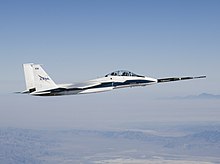
- F-15 Streak Eagle (AF Ser. No.72-0119)
- One stripped of most avionics and unpainted F-15A, demonstrated the fighter's acceleration – broke eight time-to-climb world records between 16 January and 1 February 1975 at Grand Forks AFB, ND. It was delivered to the National Museum of the United States Air Force in December 1980.[2]
- F-15 STOL/MTD (AF Ser. No. 71-0290)
- The first F-15B was converted into a short takeoff and landing, maneuver technology demonstrator aircraft.[93] In the late 1980s it received canard flight surfaces in addition to its usual horizontal tail, along with square thrust-vectoring nozzles. It was used as a short-takeoff/maneuver-technology (SMTD) demonstrator.[94]
- F-15 ACTIVE (AF Ser. No. 71-0290)
- The F-15 S/MTD was later converted into an advanced flight control technology research aircraft with thrust vectoring nozzles.[93]
- F-15 IFCS (AF Ser. No. 71-0290)
- The F-15 ACTIVE was then converted into an intelligent flight control systems research aircraft. F-15B 71-0290 was the oldest F-15 still flying when retired in January 2009.[94]
- F-15 MANX
- Concept name for a tailless variant of the F-15 ACTIVE, but the NASA ACTIVE experimental aircraft was never modified to be tailless.
- F-15 Flight Research Facility (AF Ser. No. 71-0281 and AF Ser. No. 71-0287)
- Two F-15A aircraft were acquired in 1976 for use by NASA's Dryden Flight Research Center for numerous experiments such as: Highly Integrated Digital Electronic Control (HiDEC), Adaptive Engine Control System (ADECS), Self-Repairing and Self-Diagnostic Flight Control System (SRFCS) and Propulsion Controlled Aircraft System (PCA).[95] 71-0281, the second flight-test F-15A, was returned to the Air Force and became a static display at Langley AFB in 1983.
- F-15B Research Testbed (AF Ser. No. 74-0141)
- Acquired in 1993, it was an F-15B modified and used by NASA's Dryden Flight Research Center for flight tests.[96]
Operators
For operators of F-15E, F-15I, F-15S, F-15K, F-15SG, and other F-15E-based variants, see McDonnell Douglas F-15E Strike Eagle.
Main article: List of F-15 operators
 Israel
Israel
- Israeli Air Force has operated F-15s since 1977. The IAF has 43 F-15A/B/C/D (20 F-15A, 6 F-15B, 11 F-15C, and 6 F-15D) aircraft in service as of January 2011.[97]
 Japan
Japan
- Japan Air Self-Defense Force operates Mitsubishi F-15J and F-15DJ fighters.
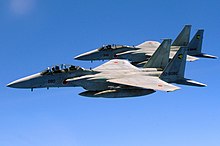
 Saudi Arabia
Saudi Arabia
- Royal Saudi Air Force has 70 F-15C/D (49 F-15C and 21 F-15D) Eagles in operation as of January 2011.[97]
 USA
USA
- United States Air Force operates 254 F-15C/D aircraft (114 Regular Air Force and 140 Air National Guard) as of September 2010.[98][99]
- NASA used to test Highly Integrated Digital Engine Control system (HIDEC) at Edwards AFB, 1988[100]
Notable accidents
Main article: List of F-15 losses
- On 1 May 1983, an Israeli Air Force F-15D collided with a Douglas A-4 Skyhawk during training. Unknown to pilot Zivi Nedivi and his copilot, the right wing was sheared off roughly two feet (60 cm) from the fuselage. The A-4 disintegrated and its pilot safely ejected, while the F-15 nosed down and entered a violent roll. Zivi decided to attempt recovery and engaged afterburner to increase speed, allowing him to regain control. The pilot was able to prevent stalling and maintain control because of the lift generated by the large horizontal surface area of the fuselage, the stabilators, and remaining wing areas. The F-15 landed at twice the normal speed to maintain the necessary descent and its tailhook was torn off during the landing. Zivi managed to bring his F-15 to a complete stop approximately 20 ft (6 m) from the end of the runway. He was later quoted as saying "It's highly likely that if I would have seen it clearly, I would have ejected..."; the fuel leak and vapors along the wing had prevented him from seeing what had happened to the wing itself. The aircraft was repaired and saw further combat service.[101][102][103]
- On 19 March 1990, an F-15 from the 3rd Wing stationed at Elmendorf AFB, Alaska accidentally fired an AIM-9M Sidewinder missile at another F-15. The damaged aircraft was able to make an emergency landing; it was subsequently repaired and returned to service.[104] This was not in combat, but does mark the first time an F-15 was struck by an air-to-air missile, accident or otherwise.
- On 22 November 1995, during air-intercept training over the Sea of Japan, a Japanese F-15J flown by Lt. Tatsumi Higuchi was shot down by an AIM-9L Sidewinder missile inadvertently fired by his wingman in an accident similar to the one that occurred on 19 March 1990. The pilot ejected safely. Both F-15Js involved were from JASDF 303rd Squadron, Komatsu AFB.[105]
- On 26 March 2001, two US Air Force F-15Cs crashed near the summit of Ben Macdui in the Cairngorms during a low flying training exercise over the Scottish Highlands.[106] Both Lieutenant Colonel Kenneth John Hyvonen and Captain Kirk Jones died in the accident, which resulted in a court martial for an RAF air traffic controller, who was later found not guilty.[107][108]
- On 2 November 2007, a 27-year-old F-15C (AF Ser. No. 80-0034) of the 131st Fighter Wing, Missouri Air National Guard), crashed following an in-flight breakup due to structural failure during combat training near St. Louis, Missouri. The pilot, Major Stephen W. Stilwell, ejected but suffered serious injuries. On 3 November 2007, all non-mission critical F-15s were grounded pending the crash investigation's outcome, only in emergencies could these aircraft be used.[109][110] By 13 November 2007, over 1,100 were grounded worldwide after Israel, Japan and Saudi Arabia grounded their aircraft as well.[111] F-15Es were cleared on 15 November 2007 pending individual inspections.[112] On 8 January 2008, the USAF cleared 60 percent of the F-15A/B/C/D fleet to fly.[76] On 10 January 2008, the accident review board released its report, which attributed the crash to the longeron not meeting specifications.[77] On 15 February 2008, the Air Force cleared all F-15s for flight, pending inspections and any needed repairs.[79] In March 2008, Stilwell filed a lawsuit against Boeing.[113]
- On 20 February 2008, two F-15Cs from the 58th Fighter Squadron, 33rd Fighter Wing at Eglin AFB, Florida, flown by 1st Lt Ali Jivanjee and Capt Tucker Hamilton collided over the Gulf of Mexico during a training mission. Both pilots ejected and were rescued, but one died later from his injuries.[114] The accident investigation report released 25 August 2008 found that the accident was the result of pilot error. Both pilots failed to clear their flight paths and anticipate their impending high-aspect, midair impact according to Brig Gen Joseph Reynes Jr., the leader of the investigation team.[115]
For accidents involving F-15E and related variants, see List of F-15 losses.
Specifications (F-15C)
Data from USAF fact sheet,[116] Jane's All the World's Aircraft,[117] Combat Legend, F-15 Eagle and Strike Eagle[118]
General characteristics- Crew: 1: pilot
- Length: 63 ft 9 in (19.43 m)
- Wingspan: 42 ft 10 in (13.05 m)
- Height: 18 ft 6 in (5.63 m)
- Wing area: 608 ft² (56.5 m²)
- Airfoil: NACA 64A006.6 root, NACA 64A203 tip
- Empty weight: 28,000 lb (12,700 kg)
- Loaded weight: 44,500 lb (20,200 kg)
- Max. takeoff weight: 68,000 lb (30,845 kg)
- Powerplant: 2 × Pratt & Whitney F100-100 or −220 afterburning turbofans
- Dry thrust: 14,590 lbf[119] (64.9 kN) each
- Thrust with afterburner: 23,770 lbf for −220[119] (105.7 kN for −220) each
- Fuel capacity: 13,455 lb (6,100 kg) internal[120]
- Maximum speed:
- High altitude: Mach 2.5+ (1,650+ mph, 2,665+ km/h)
- Low altitude: Mach 1.2 (900 mph, 1,450 km/h)
- Combat radius: 1,061 nmi (1,222 mi, 1,967 km) for interdiction mission
- Ferry range: 3,450 mi (3,000 nmi, 5,550 km) with conformal fuel tanks and three external fuel tanks
- Service ceiling: 65,000 ft (20,000 m)
- Rate of climb: >50,000 ft/min (254 m/s)
- Wing loading: 73.1 lb/ft² (358 kg/m²)
- Thrust/weight: 1.07 (−220)
- Maximum design g-load: 9 g
- Guns: 1× 20 mm (0.787 in) M61 Vulcan 6-barreled Gatling cannon, 940 rounds
- Hardpoints:
Total 11 (not including CFTs): two under-wing (each with additional two
missile launch rails), four under-fuselage (for semi-recessed carriage
of AIM-7 Sparrows) and a single centerline pylon station, optional
fuselage pylons (which may include conformal fuel tanks, known initially as Fuel And Sensor Tactical (FAST) pack for use on the C model) with a capacity of 16,000 lb (7,300 kg) and provisions to carry combinations of:
- Missiles:
- 4× AIM-7 Sparrow
- 4× AIM-9 Sidewinder
- 8× AIM-120 AMRAAM
- Bombs:
- Other:
- up to 3× 600 US gallons (2,300 L) external drop tanks for ferry flight or extended range/loitering time.
- MXU-648 Cargo/Travel Pod – to carry personal belongings, and small pieces of maintenance equipment.[91]
- Missiles:
- Radar:
- Countermeasures:
- Northrop Grumman Electronic Systems AN/ALQ-131 electronic countermeasures pod[123]
- Hazeltine AN/APX-76 or Raytheon AN/APX-119 Identify Friend/Foe (IFF) interrogator[124]
- Magnavox AN/ALQ-128 Electronic Warfare Warning Set (EWWS) – part of Tactical Electronic Warfare Systems (TEWS)[123]
- Loral AN/ALR-56 Radar warning receivers (RWR) – part of TEWS[125]
- Northrop Grumman Electronic Systems ALQ-135 Internal Countermeasures System (ICS) – part of TEWS[123]
- Marconi AN/ALE-45 Chaff/Flares dispenser system – part of TEWS[126]
Aircraft on display
Although the F-15 continues to be a front-line fighter, a number of older USAF and IAF models have been retired, with several placed on outdoor display or in museums. These include:Germany
- F-15A
- 74-0085 - Spangdahlem AB.[127]
- 74-0109 - Auto Technik Museum, Speyer.[128]
Netherlands
- F-15A
- 74-0083 (Marked as 77-0132) - Militaire Luchtvaart Museum, Kamp Zeist.[129]
Japan
- F-15A
Israel
- F-15A
United Kingdom
- F-15A
- 74-0131 - Wings of Liberty Memorial Park, RAF Lakenheath.[133]
- 76-0020 - American Air Museum, Duxford.[134]
United States
- F-15A
- 71-0280 - Lackland AFB, Texas.[135]
- 71-0281 - Langley AFB, Virginia.[136]
- 71-0283 - Defense Supply Center Richmond, Richmond, Virginia.[137]
- 71-0285 - USAF Personnel Recruiting Office, St. Louis, Missouri.[138]
- 71-0286- Octave Chanute Aerospace Museum, Rantoul, Illinois.[139]
- 72-0119 "Streak Eagle" - in storage at the National Museum of the United States Air Force, Wright-Patterson AFB, Dayton, Ohio.[140]
- 73-0085 - Museum of Aviation, Robins AFB, Warner Robins, Georgia.[141]
- 73-0086 - Louisiana Military Museum, Jackson Barracks, New Orleans, Louisiana.[142]
- 73-0099 (Marked as 77-0099) - Robins AFB, Warner Robins, Georgia.[143]
- 74-0081 - Elmendorf AFB, Alaska.[144]
- 74-0084 - Alaska Aviation Heritage Museum, Anchorage, Alaska.[145]
- 74-0095 - Tyndall AFB, Panama City, Florida.[146]
- 74-0114 - Mountain Home AFB, Idaho.[147]
- 74-0117 - Langley AFB, Virginia.[148]
- 74-0118 - Pima Air & Space Museum, adjacent to Davis-Monthan AFB, Tucson, Arizona.[149]
- 74-0119 - Castle Air Museum, Atwater, California.[150]
- 74-0124 - Air Force Armament Museum, Eglin AFB, Florida.[151]
- 75-0026 - National Warplane Museum, Elmira Corning Regional Airport, New York.[152]
- 75-0045 - USS Alabama Battleship Memorial Park, Mobile, Alabama.[153]
- 76-0008 - March Field Air Museum at March ARB, Riverside, California.[154]
- 76-0009 - Kingsley Field Air National Guard Base, Klamath Falls, Oregon.[155]
- 76-0014 - Evergreen Aviation Museum, McMinnville, Oregon.[156]
- 76-0018 - Hickam Field, Joint Base Pearl Harbor-Hickam, Oahu, Hawaii.[157]
- 76-0024 - Peterson Air and Space Museum, Peterson AFB, Colorado.[158]
- 76-0027 - National Museum of the United States Air Force, Wright-Patterson AFB, Dayton, Ohio.[159]
- 76-0037 - Holloman AFB, New Mexico.[160]
- 76-0040 - USAF Academy, Colorado Springs, Colorado.[161]
- 76-0048 - McChord Air Museum, McChord AFB, Washington.[162]
- 76-0063 - Pacific Aviation Museum, Ford Island, Joint Base Pearl Harbor-Hickam, Hawaii.[163]
- 76-0066 - Portland Air National Guard Base, Oregon.[164]
- 76-0076 (Marked as 33rd Fighter Wing F-15C 85-0125) - roadside park, DeBary, Florida.[165]
- 76-0080 - Jacksonville Air National Guard Base, Florida.[166]
- 76-0088 - St. Louis Air National Guard Station, Lambert Field, Missouri.[167]
- 76-0108 - Lackland AFB/Kelly Field Annex, Texas.[168]
- 76-0110 - gate guard, Mountain Home AFB, Idaho.[169]
- 77-0068 - Arnold AFB, Manchester, Tennessee.[170]
- 77-0090 - Hill Aerospace Museum, Hill AFB, Utah.[171]
- 77-0102 - Pacific Coast Air Museum, Charles M. Schulz-Sonoma County Airport, Santa Rosa, California. One of two Massachusetts Air National Guard 102d Fighter Wing aircraft scrambled in first response to terrorist air attacks on 11 September 2001.[172]
- 77-0146 - Veterans Park, Callaway, Florida.[173]
- 77-0150 - Yanks Air Museum, Chino, California.[174]
- F-15B
- 73-0108 - Luke AFB, Arizona.[175]
- 73-0114 - Air Force Flight Test Center Museum, Edwards AFB, California.[176]
- 75-0084 - On display at the Russell Military Museum located in Russell, Illinois.
- 77-0161 - Seymour Johnson AFB, Goldsboro, North Carolina.[177]
Notable appearances in media
Main article: F-15 Eagle in fiction
The F-15 was the subject of the IMAX movie Fighter Pilot: Operation Red Flag, about the RED FLAG exercises. In Tom Clancy's nonfiction book, Fighter Wing (1995), a detailed analysis of the Air Force's premier fighter aircraft, the F-15 Eagle and its capabilities are showcased.[178]The F-15 has also been a popular subject as a toy, and a fictional likeness of an aircraft similar to the F-15 has been used in cartoons, books, video games, animated television series, and animated films. The F-15 was mentioned in a veteran's old war story in the 2005 song Something to Be Proud Of by Montgomery Gentry.[179]
See also
- Related development
- Aircraft of comparable role, configuration and era
- Related lists
The Amazing Saga Of How Israel Turned Its F-15s Into Multi-Role Bombers
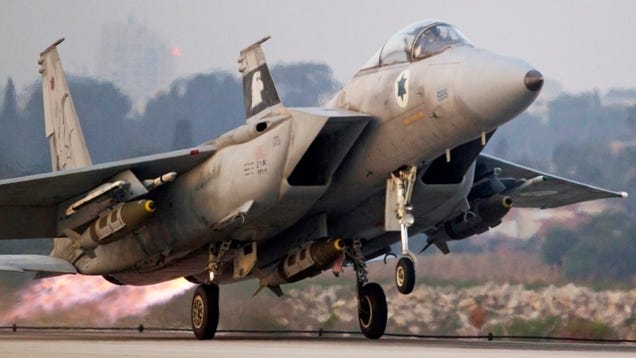
When the F-15 was created, it was created to be a pure air-to-air fighter, with the philosophy of “not a pound for air-to-ground”
guiding designers. So how did Israel end up turning their F-15s into
deadly long-range multi-role strike aircraft well before the F-15E
Strike Eagle became a reality? Here’s how.
In Need Of A Game Changing Fighter
Israel’s
love affair with the F-15 began out of the need to procure a fighter
that could trump the increasingly complex fighters that surrounding Arab
states were amassing from Russian and French sources. Both the F-14
Tomcat and the F-15 Eagle were tested by Israel Air Force pilots in the
US during the mid 1970s, with the Eagle being chosen hands down over the
Tomcat. In Hebrew, they call it the “Baz.”
Israel
received the first of its initial order of two single seat F-15As and
two, two seat F-15Bs in 1976 under the Peace Fox foreign military sales
program. These aircraft were largely used as test, training and
evaluation planes so that the Israeli Air Force could prepare for its
full order to arrive. Another 19 F-15As and two F-15Bs were delivered by
1978, entering active service with 133 Squadron at Tel Nof airbase.

The Baz
represented a quantum leap in capability for the IAF, with the service
having flown the F-4, A-4 and Mirage series prior to it, and was far and
away the most capable fighter aircraft in the region during the 1970s.
Well, at least aside from Iran’s then growing F-14A fleet.
The Baz was
truly a national source of pride in Israel at the time of its arrival
and remains so to this day, with only the IAF’s very best pilots
selected to fly it. Obviously the aircraft’s strict air-to-air focus
helped with this image as the jet was viewed as a guardian of Israel, a
weapon that would ensure the country’s ability to exist through
overwhelming air superiority capability.
Israeli
F-15A and Bs were quick to live up to their hype, shooting down five
Syrian MiG-21s over Lebanese skies on June 27th, 1979. More Syrian kills
followed that September. Then, on February 13th, 1981, the Baz shot
down the very aircraft that spurred the F-15’s original development in
the late 1960s, a high and fast flying MiG-25 Foxbot, also of Syrian origin.
Israeli F-15s went on to support Operation Opera, the IAF’s daring raid on Iraq’s nuclear reactor. Six F-15s would provide counter-air escort the eight newly received F-16s that would do the bombing. The high-risk mission was a massive success.
The Baz fleet would then go on to score dozens of kills against Syrian MiGs during the Lebanon War of 1982. IAF Brig. Gen. Moshe Marom-Melnik explained just how powerful the Baz was even against waves of Syrian MiGs:
“We kept the Syrians from flying in Lebanon, and did it in the best possible fashion. Every flight of Syrian planes that tried to cross the lines and attack our forces in Lebanon was shot down. Sometimes a single plane out of the flight escaped and told the others the story of what had happened. We had a field day, basically, shooting down practically everything that flew. The MiG-21 and MiG-23, which formed the backbone of the Syrian air force, were crushed. As far as our squadron was concerned, the war was more like a shooting range.”
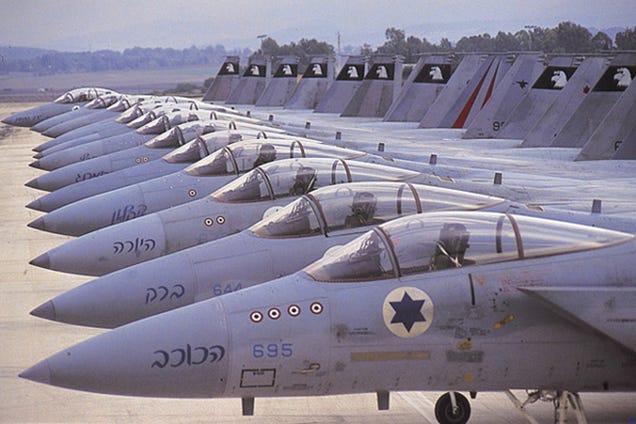
During the
early 1980s, the IAF received the improved F-15C/D Baz. 18 F-15Cs and 8
F-15Ds were delivered during the 1982-1983 timeframe. These new jets
were more capable than their predecessors in almost every respect,
although their airframe remained visually nearly identical to the older
A/B models. These F-15C/Ds were in no way replacements for the IAF’s
older A/B models, instead they were meant to augment and grow Israel’s
cherished and battle proven Baz force and would work alongside the
equally as new and growing fleet of F-16A/Bs.
Operation Wooden Leg- The Multi-Role Eagle Is Born
The very
idea of what the Baz/Eagle is, and how it could be used in combat, was
totally changed on October 1st, 1985 when six F-15Ds and two F-15Cs flew
over 1200 miles from their Israeli bases across the Mediterranean Sea
to strike the PLO’s headquarters located on the coast of Tunis, Tunisia.
This complex and risky strike, which was dubbed Operation Wooden Leg,
was in retaliation for the supposed murder of three innocent Israelis
yachting off of Cyprus. The PLO claimed they were Israeli spies.
At the
time, this was the longest-range IAF airstrike ever, which took
advantage of the Eagle’s great endurance, especially the new C/D models
which carried approximately 2,000lbs of additional internal fuel than
their predecessors. It was also made possible by IAF’s new aerial
refueling capabilities, with two KC-707s being used as tankers and
command posts for the mission. The tankers were procured in 1983 and the
idea to give the Baz some sort of precision guided strike capability
began around that same time. By 1985, crews were trained and the gear
was ready for just this type of operation.
Still, training for something and executing it in reality are two entirely different things.

In order
for the mission to succeed, the flight had to remain undetected by North
African countries, as well as Syrian and even U.S. Naval vessel’s
radars. As a result, the route was far from direct. An Israeli vessel
with a helicopter aboard was pre-positioned off of Malta should any of
the crews have to eject. Also, two spare F-15s, in addition to the eight
primary attacker F-15s, would make it to the first refueling point
before turning back. This was a hedge against any mechanical failures
with the primary attack force.
Although
the distances involved in the strike were groundbreaking, the fact that
the F-15 would prove its ability to be adapted for the ground attack
role in actual combat was monumental. The F-15A-D was actually built
with a very austere ground attack capability based around gravity
bombing with basic Mk82, 83 and 84 general purpose bombs. This largely
dormant capability has never been exercised by any other operator but
the IAF. Still, having the Baz lob dumb bombs at targets could not
provide enough precision for such a high-value operation as Wooden Leg,
which was aimed at telling the PLO, and the world, that Israel could
retaliate against its enemies anywhere in the world via air power, with
devastating results.
With this goal in mind, the six F-15Ds used in the strike were equipped with the ability to launch and guide a pair of 2,000lb GBU-15 optically
guided glide bombs, with the backseaters controlling the massive
weapons via a man-in-the-loop, two way data-link pod mounted on the
Eagle’s centerline station.
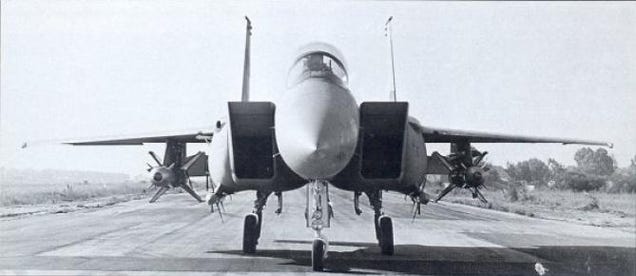
The GBU-15
has a range of about 24 miles when launched from 40,000 feet, but in
practice, a launch from 25,000 feet, with a range of about 12-15 miles
is more common. The other two aircraft used on the raid were F-15Cs,
which would be the last aircraft on target. They carried six 500lb Mk82s
general purpose bombs each on a multiple ejector bomb racks attached to
the Baz’s centerline station. In addition to air-to-ground weaponry,
the Eagles flew with AIM-7 Sparrows and their 20mm cannon magazines
topped off with 940 rounds (510 rounds in the D model), just in case an
aerial threat materialized.
The jets,
which had all their identifying marks stripped off before the mission,
made it to their targets undetected. As the first wave of three Bazs
approached the coastline they launched their weapons and obtained
perfect results, with the second trio launching theirs GBU-15s shortly
after. The flight lead then joined with the final pair of F-15Cs after
the first 5 jets turned back towards the east, their wing stations now
empty. He then push into the target area with the last two F-15Cs for
their bomb runs, working as a spotter and taking photos of the damage
for later assessment.
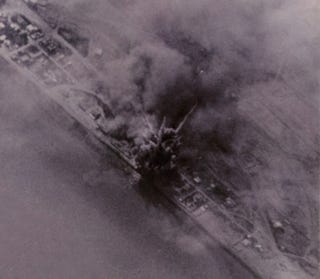
Almost
every weapon hit their intended target, obliterating the PLO
headquarters totally. For the IAF, the mission was a massive success,
obliterating the briefed targets and killing large amounts of PLO
personnel (IAF claimed around 60 PLO personnel were killed, while others
claimed the death rate to be in the hundreds). The attacks resulted in
broad international condemnation, even from the US, although for the
Israelis the message they wanted to send to the world could not have
been clearer. On top of this, they realized that their F-15 Baz fleet,
which gained Israel air supremacy once and for all over the region in
years prior, could become so much more, it could be a deterrent force
aimed at enemies far from Israel’s borders.
Strike Eagles And FAST Packs
Although
details of Israel’s startlingly long-ranged attack were kept out of the
public eye following the mission, US intelligence services were surely
aware of exactly how the mission was executed after the fact. The use of
lightly modified F-15C/D Bazs undoubtedly gave further heft to the then
finally blossoming F-15E Strike Eagle program, which had been
envisioned in different configurations by McDonnell Douglas and the USAF
as far back as the mid 1970s.
The F-15E’s official first flight, after the demonstrator beat out the F-16XL
during a fly-off competition, would occur just a year after Operation
Wooden Leg, with its introduction into USAF service occurring in 1988,
although without many of its most advanced features available.
One of the
features that the F-15E would be built with was conformal fuel tanks,
otherwise known as “FAST Packs,” as in Fuel And Sensor Tactical Packs.
These flank hugging 849 gallon tanks were not new to the F-15 with the
advent of the Strike Eagle, in fact they were envisioned as an option
for the F-15C/D and even retrofittable to the A and B models early on,
with the first test flight being flown with them attached to an Eagle in
the mid 1970s. They were envisioned to carry everything from fuel to
cargo, although the majority of these concepts never made it to
fruition.

USAF Eagles
only took limited advantage of FAST packs, with some jets deployed to
Iceland or stationed in Alaska using them sporadically for the
long-range air sovereignty role. The IAF on the other hand saw the great
utility in these conformal fuel tanks, not just to enhance range, but
to make their air superiority focused Bazs true multi-role heavy
fighters.
Like those
found on the F-15E, F-15 Baz’s conformal tanks could be fitted with
hardpoints for air-to-air missiles or for bombs. This allows for the Baz
to fly missions with a pair of underwing tanks and even a centerline
tank while still being able execute air-to-ground missions. Today, many
Bazs can be seen fitted with indigenously developed FAST Packs built by
IAI, but the fact is these were flying on Bazs many decades ago.
By many
accounts, they we integral in giving the aircraft flown on Operation
Wooden Leg enough range to make the mission possible, as their two wing
stations were filled with one GBU-15 each, and their centerline station
was fitted with the data-link pod needed to control these weapons. As a
result, there was no room for external tanks aside from the FAST packs.
The IAF’s
love affair with conformal fuel tanks continues on today, not just on
the remaining Baz fleet, but also on every fighter aircraft ordered
since the early 1990s. Additionally, fuel is not the only thing they
carry. Sensors and emitters can also be fitted within them, giving the
Baz a whole range of secondary mounting options beyond just its stock
hardpoints.
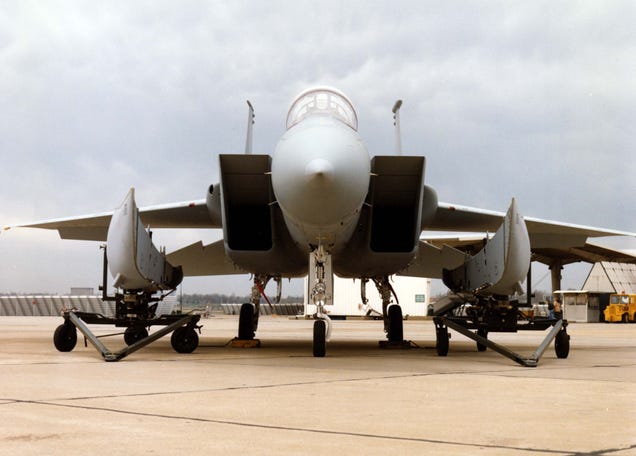
Upgrades And Final Baz Orders
By the late
1980s, the IAF took delivery of yet another batch of F-15C/Ds, some of
the last ever built. Then, following the Gulf War, the US awarded Israel
with 12 surplus F-15As and a single surplus F-15B, all from Louisiana
Air National Guard stocks, as a thank you for not intervening in
Operation Desert Storm even though Saddam’s SCUD missiles were fell on
the country throughout the conflict. Exactly what happened to these
aircraft remains unclear. Some were said to have been in worse condition
than Israel’s own F-15A/Bs, although the B model, which the IAF puts a
heavy value on, was surely integrated into the Baz fleet. The rest of
the aircraft may have been used for training and/or cannibalized for
spare parts.
During this
same time period, much like its once Fleet Defender turned attack
aircraft naval counterpart, the F-14 Tomcat, the Baz fleet received
small upgrades enhancing its ability to attack ground targets. The
longer range Popeye air-to-surface missile was integrated into the Baz’s repertoire,
which greatly expanded the Baz’s standoff ground attack range to almost
50 miles. Still, the Popeye used a similar, demanding control interface
as the GBU-15 and it was an expensive and powerful weapon. Nonetheless,
it made the Baz fleet more capable of striking targets deep in highly
defended enemy territory than ever before.
The Python 4 high-off-boresight short-range air-to-air missile and
the Elbit DASH helmet mounted sight were introduced into the fleet as
well. This gave Baz pilots the ability to engage enemy fighters far off
the jet’s centerline by having the pilot simply look at the target and
fire the missile. This was a first for the F-15 and a capability that
would only come to USAF F-15s well over a decade later in the form of
the Joint Helmet Mounted Cuing System and the AIM-9X Sidewinder.
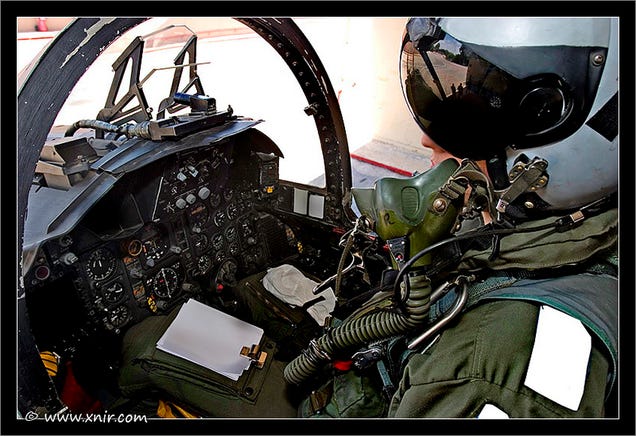
The Baz also saw air-to-ground combat once again during Operation Accountability
on July 25, 1993, striking Hezbollah targets in Lebanon. This was the
first time the Baz had hit targets in the regional defense role,
something that would become a bread and butter mission for the big
fighter in the new millennium.
Baz 2000 and The F-15I Ra’am
The
Louisiana air guard surplus F-15As and single F-15B were the last batch
of F-15 Bazs delivered to the IAF, with orders switching over to the F-15E Strike Eagle derivative, known as the F-15I “Ra’am” or “Thunder” after 1993.
Ever since
the Strike Eagle become operational in USAF service, Israel was
interested in buying the advanced jet, yet the US was not willing to
sell it to them. Then, the signing of the Oslo Accords
occurred in 1993, which opened the door for Israel’s Strike Eagle
wishes to become a reality. This is very similar as to how the signing
of the Egypt-Israeli peace treaty opened the door to the F-16 for the
IAF about a decade and a half earlier.
Price was a
major issue surrounding the Strike Eagle purchase. The aircraft would
cost almost three times that of an F-16, and close to double that of a
F/A-18. The fact that unique Israeli sub-systems would need to be
integrated into the Strike Eagle design only made procuring large
amounts of the jets more cost prohibitive. Israel even looked at buying
used F-111s Aardvarks instead of the Strike Eagle, along with more
F-16s, as a way to get more value for their dollar. After closely
examining F-111 operations at RAF Lakenheath in England, they realized
the maintenance required for the swing-wing bombers would be
prohibitive. Also, the F-111 had very little ability to defend itself
against enemy fighters, so it would still rely on the F-15 to get its
job done.
In the end,
a total of just 25 of the Strike Eagle derivatives would be ordered and
they would become the most capable fighter in IAF service. As a way of
augmenting the reduced F-15I buy, Israel would procure a similarly
modified, but much more plentiful F-16I “Sufa,” or “Storm,” fighter fleet of 100 jets.
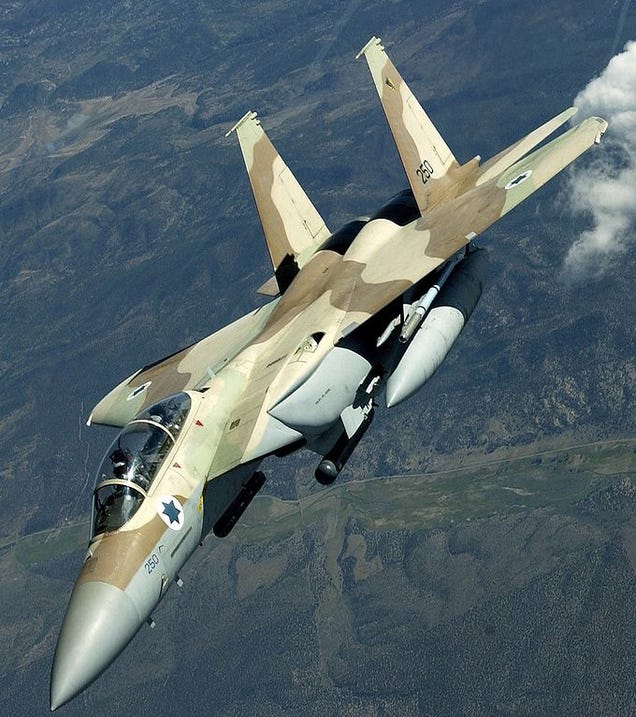
By the mid
1990s, with 100 F-16Is and 25 F-15Is on order, Israel turned its focus
on a much needed deep F-15 Baz upgrade program, with enhancements
similar to those found in the USAF’s F-15 MSIP (Multi-Stage Improvement
Program). Israel had to chose between going through an American led
improvement program, or largely going about enhancing the now dated Baz
for the coming decades on its own.
The IAF
chose to indigenously upgrade the Baz fleet, mainly due to cost and the
fact that their own unique sub-systems would have to be integrated
anyway. Known as the Baz 2000 program, this reworking of the best of the
IAF’s Baz fleet would give F-15A/B/C/D aircraft a common cockpit
configuration, although that was just the start of the improvements.
Many of the
upgrades were ported over from the F-15I, while others were unique to
the Baz fleet. The radars were upgraded to fire the AIM-120 AMRAAM. A
new Hands-On Throttle And Stick setup was installed. Multi-function
displays were added to the cockpit, both front and aft in the B/D
model’s case. Enhanced data-links and updated communications gear were
installed. A new electronic warfare suite was also integrated into the
middle aged jets along with new mission computers and navigation systems
(with embedded GPS). Enhanced cooling was also a much needed feature.
To support these new systems, the Bazs were totally rewired, which in
itself was an impressive feat.
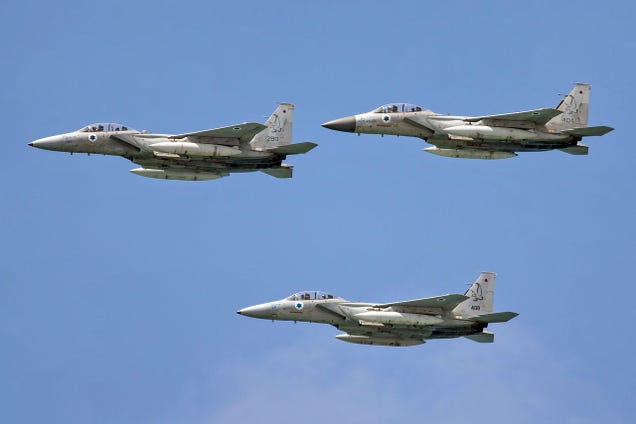
In the end,
the Baz 2000 initiative gobbled up an incredible 8,000 man hours per
jet and ran from 1995 to 2005. Israeli technicians found that many jets
was built slightly differently, so they could not just replace one black
box with another, each jet had to be worked on in a one by one basis.
The whole process was said to be a grueling one.
The result
of the costly program was a Baz that looked very similar to the way it
did decades before, but when it came to deadliness and adaptability, it
was an entirely different animal. Because Israel had flown the wings off
(literally!) of a good portion of the oldest Baz fleet, not every
available airframe was put through the Baz 2000 upgrade program, with
only the cream of the fleet (about 50 aircraft) being renewed for
decades of future operations.
The Baz Is Old But Wise
Israel’s reinvigorated Baz fleet has never been more relevant than it is today. The advent of GPS guided weaponry, such as the JDAM,
allows them to finally work as pinpoint, all weather, fixed target
strikers without having to rely on cumbersome optically guided weaponry.
They can also still work as standoff weapons haulers as they had for
decades, the only difference being that now Israel has a whole array of
standoff weaponry that can be tailored to the target at hand. In
addition, the Baz’s speed, range and stability made it an ideal platform
for tactical reconnaissance, and large reconnaissance pods have been
seen slung underneath these jets over the last decade or so.
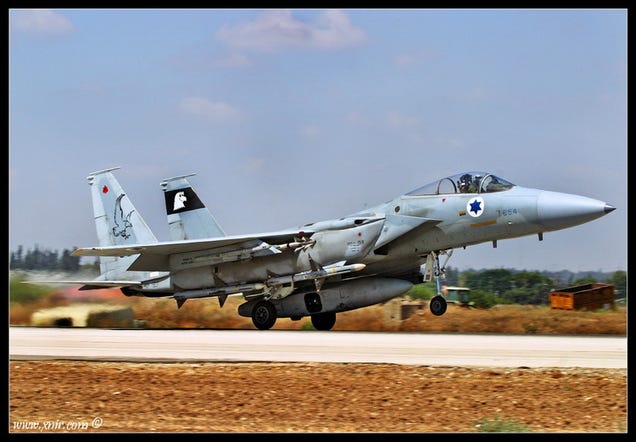
Because the
Baz still has similar range as its more contemporary successors, the
F-15I and the F-16I, it can work as a forward deployed networking and
command and control node, absorbing the battle picture via data-link
from fighters within its line of sight and then beaming this information
up to a satellite, which then beams it back down to Israeli commanders
hundreds, or even thousands of miles away. This can also go in the
opposite direction, with new orders, alerts of pop-up air defenses, and
other updates being sent from behind friendly lines or from orbiting
strategic intelligence aircraft to the F-15B/D Baz. From here, the Baz
can disperse this information to the rest of the non-satellite
communications equipped strike package.
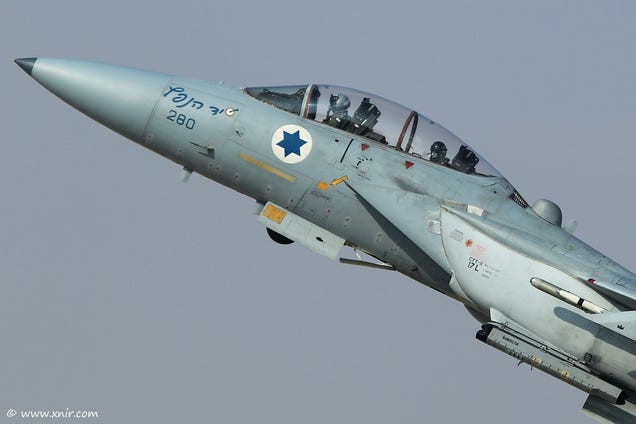
This high
bandwidth satellite communications modification can be seen on F-15B/Ds
packing a large bulbous R2-D2 like satellite communications dome just
behind the environmental cooling system vent, located on the jet’s
forward spine..
Going
‘downtown’ over enemy territory with a strike package is something a
traditional command and control aircraft cannot do, but the Baz can. In
fact, it can do this while also doing other tasks, such as electronic
warfare, attacking fixed targets or conducting counter-air duties. The
later of which is what the Baz was originally envisioned for, and with
an unbeaten Israeli combat record to this day of 50 to 0, it is a
mission the jet is still very capable of.
The Baz Continues To Confront Threats Both Old And New
In recent
years, the upgraded Baz fleet has been used in conflicts near and within
Israel’s borders as well as far beyond them. With the IAF taking out
Syrian and Hezbollah targets on a seemingly regular basis, and
long-range raids, like the one on the Khartoum weapons dump in 2012, continuing
to be an operational reality, the IAF’s F-15 fleet remains a cherished
resource. Additionally, the Baz has been used on attack missions within
Israel’s own borders during conflicts in Gaza, the most recent being the
wide-ranging and controversial Operation Pillar Defense.
Still, no
target looms larger for all of Israel’s longer-ranged fighter force than
Iran and its nuclear facilities. Clearly, this mission alone has helped
justify the continued investment into the aging F-15 Baz fleet. The
jet’s ability to lug large weapons over long distances and be rapidly
adapted to various roles beyond fighter or bomber makes it an intrinsic
part of any potential sustained air operation against Iranian nuclear
interests. This is especially true if Israel were to have to take a
long, round-about route to strike Iran, a feat that will push the IAF’s
small but growing tanker fleet to the absolute max.

The Baz is
scheduled to not just remain in service for decades to come, but to also
receive more investment in the form of additional upgrades. These
proposed upgrades could include improving the jet’s radar, upgrading its
electronic warfare capability, integrating new weapons, and fielding
new cockpit display interfaces. Even a possible structural upgrade may
be ordered. This should allow at least the F-15C/D portion of the Baz
fleet to continue flying well into the next two decades, at which time
it will be joined by the F-35A Joint Strike Fighter.
If the F-15C/D Baz fleet were to see an Active Electronically Scanned Array radar upgrade, similar to the USAF’s APG-63V3 radar upgrade for its Eagles,
such a powerful radar system could be a force multiplier for the rest
of Israel’s fighter fleet. It could provide long-range situational
awareness, enhanced ability to spot low-flying cruise missiles and stealthy targets in the homeland defense roll, and it could be yet another electronic attack weapon in Israel’s already bristling bag of electronic warfare tricks.
Such a
system could also benefit the F-35, which like all stealth aircraft,
best goes about its business without putting any electromagnetic energy
into the environment around it. Instead, it could use the F-15C/D’s AESA
radar information, taken from dozens of miles to its rear and sent
forward to the F-35 via data-link, to evade or even prosecute aerial
targets without emitting any electromagnetic energy at all. Similar
tactics have been developed for the USAF’ sF-15C/D and F-22 air
dominance team.
Although it
remains unclear if the Baz will make the leap into the AESA capability
space, it is possible, although it depends on Israel’s impression of the
F-35. If the F-35 becomes a favored part of the IAF’s arsenal, it will
compete for large portions of the IAF’s available funds, just like it
does within the Pentagon today. Such a struggle could limit how much
more the Baz evolves, no matter how relevant the jet remains. If further
upgrades do indeed comes to pass, the Baz could remain Israel’s long
sword and watchful sentinel for decades to come, adding to a legacy that
has become the most illustrious in the history of modern air combat.
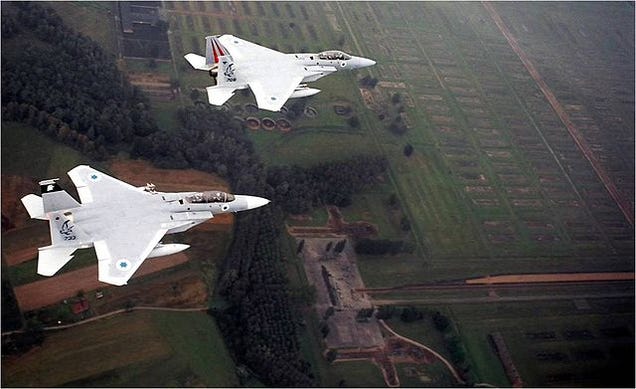
Photo credits, a huge thanks to Nir Ben-Yosef for providing the images where marked. All other images via IAF. USAF, AP, Public Domain
This Is A Fully Armed F-15SA, The Most Advanced Production Eagle Ever

The
F-15SA is the most advanced production F-15 Eagle ever built. Saudi
Arabia ordered 84 new build F-15SAs and close to 70 kits to upgrade
their existing F-15S fleet to the SA configuration. Just one part of
this upgrade is the activation of Eagle’s outboard wing stores stations,
which will expand the jet’s already heavy combat punch.

A Saudi Arabian F-15S sits on the main ramp at Nellis AFB during Red Flag
The F-15SA
is an incredibly capable machine, featuring some key changes from its
progenitor, the F-15E Strike Eagle. These include a full fly-by-wire
flight control system, APG-63V3 Active Electronically Scanned Array (AESA) radar, digital electronic warfare and radar warning suite, missile launch detection system, updated flat-panel display cockpits with helmet mounted displays in both cockpits and an infrared search and track system, known as “Tiger Eyes,”
built into the left intake targeting pod pylon. The F-15SA also
features F-110- GE-129 engines, capable of putting out almost 30,000
pounds of thrust each.
When it
comes to weapons, the F-15SA can carry almost anything in the inventory.
In the incredible image above showing an “extreme multi-role loadout”
it packs: 2x AIM-120AMRAAMs, 2x AIM-9X Sidewinders, 2x AGM-84 SLAM-ERs,
2x AGM-88 HARMs, 6x GBU-54/B Laser JDAMs, and 8x GBU-39/B Small Diameter Bombs.
Also, the
F-15SA still packs the F-15E’s 20mm Vulcan cannon with 540 rounds
available. Basically, with this jet you get a tactical fighter force “in
a box.” The loadout shown above includes weapons for long-range
stand-off deep-strike, suppression of enemy air defenses (SEAD),
counter-air, direct precision attack and standoff precision attack all
on the jet at the same time. Even after all that, the F-15SA’s
center-line station remains unused, which can accommodate up to a
2,000lb JDAM, an external fuel tank or even a synthetic aperture radar surveillance pod.

The image
above shows the F-15SA once again, albeit this time it is in an
air-to-air configuration, including no less than eight AIM-120 AMRAAMs
and eight AIM-9X Sidewinders. This amounts to double the missile carrying capability of the F-15C or F-15E.
Also note the Infrared Search and Track system mounted above the jet’s
radome. This, combined with its state of the art radar’s low probability
of intercept modes, advanced radar warning receiver and Link 16
data-link, allows the F-15SA to hunt for enemy aircraft in
electromagnetic silence while still maintain high-situational awareness.

Boeing’s
Silent Eagle features internal weapons bays in its conformal fuel
tanks
and low-observable improvements such as canted tails, radar absorbent
coatings and radar blockers on its engine fan faces. The aircraft can be
converted to a large load carrying non-stealthy configuration much like
the F-15SA in a matter of hours.
Many of the
improvements made in the penultimate F-15SA were also rolled into the
even more advanced and stealthier F-15 Silent Eagle, an aircraft that
has not found a customer in the fighter marketplace yet, especially
since South Korea chose to procure the F-35 on its last fighter buy and
other F-15 operators, like Japan, Israel, also did the same. Even if the
Eagle line ends with the F-15SA, it is amazing how far the aircraft has
come since its original use as an attack aircraft some 30 years ago.

Photos via Boeing, F-15S Red Flag Shot Via Author/Foxtrot Alpha
Contact the author Tyler@jalopnik.com





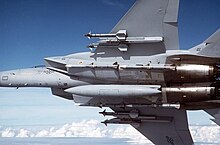


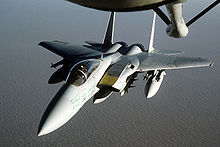


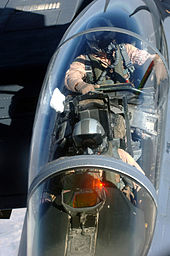

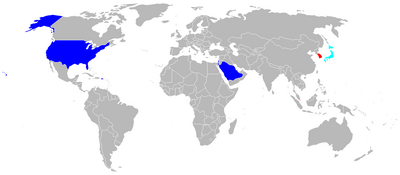






No comments:
Post a Comment